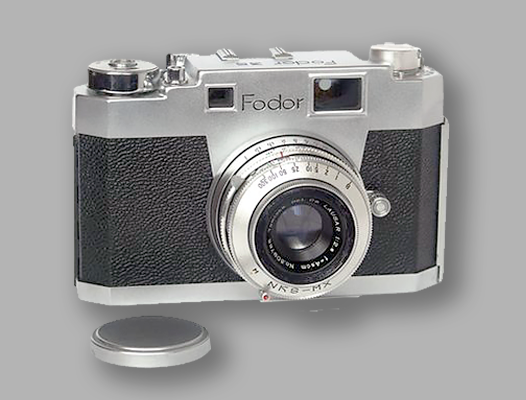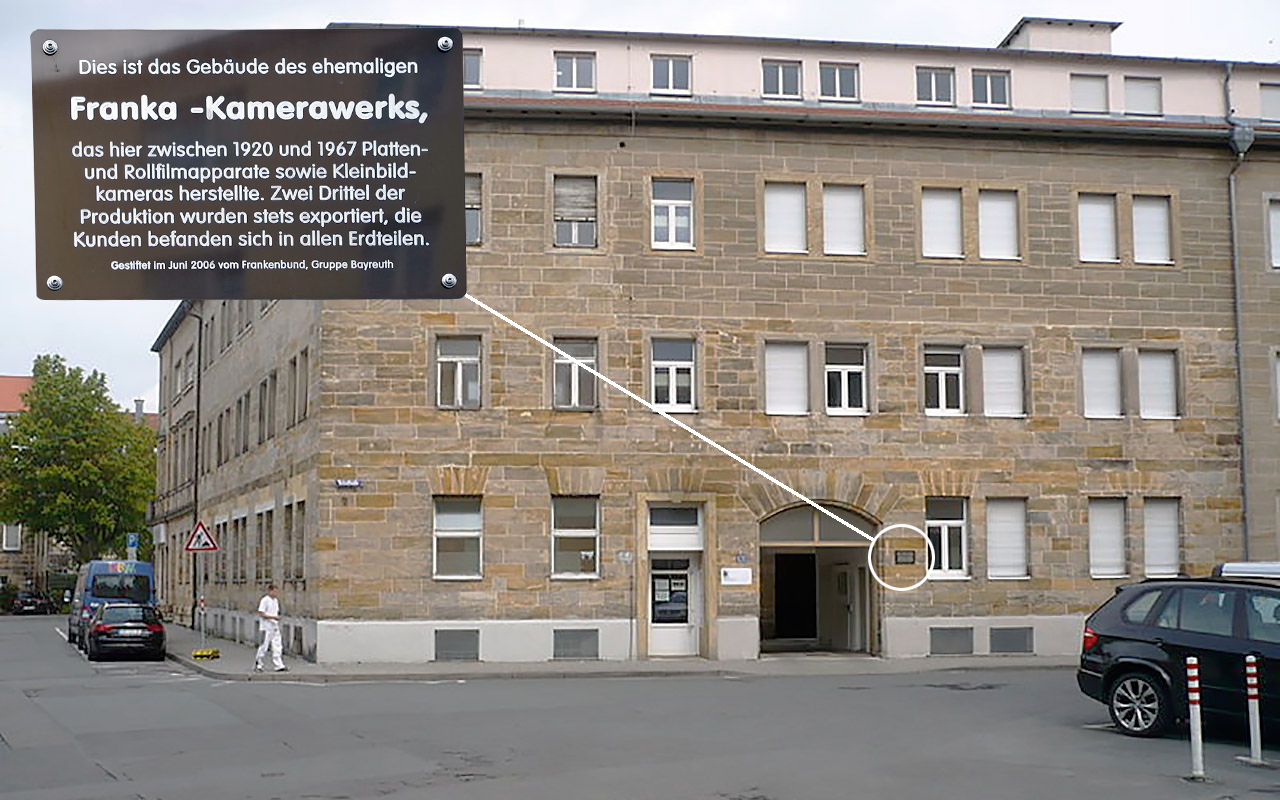Some of the following companies that manufacture(d) photographic material have already passed by in other parts of the site.Here you will find an overview of companies that marketed photographic material in the nineteenth and twentieth centuries.More is usually known about the best known or the most influential companies than about the lesser known ones; therefore they will be discussed more extensively than others.
The emphasis in this part of the site is more on the ups and downs of the company as such, while in other chapters the emphasis was on the product or on the man or woman who founded the company. The order of all companies is alphabetical.
Below are the names of the companies as will be discussed in this or any other chapter. By clicking on a name (so not on the bullet in front of it), you go directly to that part on this page where the manufacturer in question is located. Scrolling is also possible of course, but this service helps you to get to the desired manufacturer in question much faster.
Due to the fact that this introductory page has become much longer than originally planned and desirable due to the large number of manufacturers, we strongly advise you to use the name service below to go to the manufacturer of your choice on this or any subsequent page.
- General Introduction
- ADOX
- Agfa (see also Gevaert)
- Altissa
- Amaloco
- Ansco Camera Co (see also GAF)
- APM/APeM (see also Soho)
Amalgamated Photographic Manufacturers Ltd - Argus Camera Co, Ann Arbor Michigan
- Arsenal (see Kiev-Arsenal)
- Artima Export Ltd (see also Truvox)
- Asahi Pentax
- Bencini
- BOLCo and E Elliott Ltd
(abbrev. for The British Optical Lens Company) - Carl Braun Kamera-Werk
- Canon Inc.
- J.T. Chapman, Manchester
- The Chicago Cluster of Companies
(consisting of 56 companies ) - Chinon
- Concord Camera Corp.
- K.G. Corfield & K.G. Corfield (Sales) Ltd.
- Coronet Camera Company
- Cosina Company, Ltd.
- Dacora
- Dixons
- Durst
- EHO-Altissa company (See Altissa)
- E Elliott Ltd and BOLCo
(abbrev. forThe British Optical Lens Company) - Ellison Kamra
(see also QRS Devry Kamra Company) - ELOP
- Ensign Ltd. (distribution Company of Houghton-Butcher)
- Ernemann-Kamerawerke AG
- Expo Camera Company
- The FED Company
- Ferrania
- Fisher-Price
- Fodor
- Foitzik-Kamerawerke
- C.F. Foth
- Fototecnica
- Franka Kamerawerk –
- Fujica (Camera Division of Fujifilm)
- Fujifilm (brief history)
- Futura
- GAF (see also ANSCO)
(abbrev. for General Aniline & Film) - Louis Gandolfi
- Herbert George Company
- Gevaert Photo-Producten N.V. (see also AGFA)
- Girard et Cie
- GNOME
- GOERZ
- GOMZ (LOMO)
- Graflex (Folmer & Schwing)
- Great Wall Plastics Co
- W. Haking Enterprises Ltd.
- Hanimex
- Hasselblad
- Healthways
- Houghton–Butcher Manufacturing Co (See also Ensign Ltd. and Ross-Ensign Ltd.)
- R.F. Hunter Ltd.
- ICA AG
- Ihagee (Exakta)
- Ilford
- Imperial Camera Corporation
(see the Herbert George Company story ) - Jos-Pe
- Kamera-Werkstätten Guthe & Thorsch
- Keystone
- Kiev Arsenal
- KMZ
- Kochmann
- Kodak USA (incl. Australia, Canada, France, Germany & the UK)
- Konica-Minolta (Konishiroku)
(see also Minolta) - Kowa
- Krügener
- Kürbi & Niggeloh (Bilora)
- Kyocera (Yashica, Contax)
- Lancaster
- Leitz
- Lensless Camera Manufacturing Company
- Linhof
- Lipca (see also Richter-Tharandt)
- LOMO (see GOMZ)
- Loreo
- Mamiya
- Meopta Optotechnica
- Mimosa AG
- Minolta (see also Konica-Minolta)
- Minox Company
- Miranda (Orion)
- MMZ-BeLomo
- Motodori (Condor)
- Dr. August Nagel Kamera Werke
- Neidig Kamerawerk
- Nemrod-Metzeler (See Healthways)
- Nettel
- Nikon Company
- Nimslo Corporation (see also Nishika)
- Nishika Optical Systems (see also Nimslo)
- Noblex (See also K-W Guthe & Thorsch)
- Olympus Company
- ORION (see Miranda)
- ORWO
- Ottico Meccanica Italiana (OMI)
- Paterson Products Ltd.
- VEB Pentacon Dresden
- Pentax (See Asahi Pentax)
- Petri
- Photavit (Bolta)
- Plaubel
- Polaroid
- Photo Porst
- Karl Pouva – VEB Fototechnik Freital (see also Woldemar Beier)
- Purma Cameras Ltd.
- QRS Devry Kamra Company (see also Ellison Kamra)
- Foto-Quelle
- Rectaflex
- VEB Rheinmetall Büromaschinenwerk
- Richter-Tharandt (see also Lipca)
- Ricoh
- Rollei Germany
- Rollei Singapore
- Ross-Ensign
(continuation from Ensign Ltd.) - Ro-To Company
- Sea&Sea-Sunpak
- Shanghai Seagull
- Sida-Fotofex
- Sigma
- Soho Ltd (see also APM)
- Standard Cameras
- Steinheil
- Stenopeika
- Thornton-Pickard
- Topcon (Tōkyō Kōgaku)
- Tougodo Company
- Traid Corporation
- TRUVOX (see also Artima Export)
- Tura AG
- Universal Camera Corp.
- Vivitar
- Voigtländer
- Vredeborch
- Welta
- Werra (C. Zeiss Jena)
- Wirgin
- Kamera-Fabrik Woldemar Beier (see also Karl Pouva)
- Hermann Wolf GmbH
- Wünsche
- Yashica (see also Kyocera)
- Zeiss Ikon AG
- Zion
- Zunow (Teikoku Kōgaku)
FOUNDING DATE: 1927
FOUNDER: Anton Semenovich Makarenko
COMPANY NAMES:
1927: FED (the acronym of Felix Edmundovich Dzerzhinsky) which gave name to the factory and its products; 1971: Kharkiv Production Machine-Building Association “FED”; 1990: Kharkiv Scientific and Production Association “FED”; 1993: Scientific and Production Corporation of State-Owned Enterprises “FED”; 1997: Production of all types of camera has stopped. 8,647,000 cameras were manufactured since the beginning. 1998: Joint-Stock Company “Corporation “FED” (JSC “FED”); since 2007, the company’s name was “FED”.
Kharkov, Ukraine
 The FED factory in Kharkov in Ukraine was founded as a children’s commune, for children orphaned or displaced by the combined upheavals of the First World War, the Revolution and the subsequent civil war. It was founded in 1926, immediately after the death of Felix E. Dzerzhinsky (founder of the Soviet secret police) and named in his honour. Dzerzhinsky had used the power of the secret police to bring about government action to help children, so the naming is not as strange as it may seem.
The FED factory in Kharkov in Ukraine was founded as a children’s commune, for children orphaned or displaced by the combined upheavals of the First World War, the Revolution and the subsequent civil war. It was founded in 1926, immediately after the death of Felix E. Dzerzhinsky (founder of the Soviet secret police) and named in his honour. Dzerzhinsky had used the power of the secret police to bring about government action to help children, so the naming is not as strange as it may seem.
The Dzerzhinsky commune was set up and directed by educationalist Anton Semenovich Makarenko, who had previously run the Gorky Colony, also a commune for children, combining education and practical training. Whereas the Gorky Colony had been mostly agricultural, the Dzerzhinsky Commune trained children in skills such as carpentry, sewing, shoemaking and locksmithing. The products were sold, and the children were paid wages. In 1932 a new workshop was opened, making electric drills, the first in the Soviet Union.
Also in 1932, a work unit was set up to plan the production of cameras. The first three examples were made in October of that year, with lenses made by VOOMP in Leningrad, and the feat was reported in the national newspaper Izvestiya, where the cameras were described only as ‘Soviet Leicas’. These were copies of the Leica A, with an uncoupled rangefinder only as an accessory.
However, Leitz had meanwhile produced the Leica II, with a built-in coupled rangefinder. By the end of 1933, the factory had made only about 30 of its cameras. In 1934, true production began of a Leica II copy, now with lenses made by FED; about 4000 were made in the first year. Production continued until 1941, when German forces destroyed the factory, and resumed in 1946.
In the post-war years, the plant continued to produce equipment for the aviation industry, and then began to manufacture products for space industry and other machine building industry. At that time, the plant continued to manufacture cameras of the FED series. Known small cameras of the FED-5 Series, automatic cameras “FED-Micron”, “FED-Micron-2”, “FED-35”, “FED-50”, stereo-cameras “FED-Stereo” and other photographic equipment were developed and mass-produced.
Until 1955 the factory made a huge number of cameras that resemble the Leica rather closely. They are often altered, given “Leica” markings and sold as Leicas. However, the FED is cruder: for example, the rangefinder cam is pointed and not circular as in Leicas. There are differences in the shutter-release buttons and viewfinder windows. The FED has a gap in the left side of the accessory shoe. Genuine Leicas have film-loading instructions on the inner surface of the baseplate and the screws on the front are always black; on the FED these screws are chrome-coloured. Unscrupulous rebranding of Soviet-made lenses also occurs, since Industar lenses are sometimes sold as Elmar lenses. Camera collectors have described the FED as interesting and often well made and effective so long as the buyer is not deceived into paying a premium for a counterfeit Leica camera.
From 1955 FED began to innovate, combining the rangefinder with the viewfinder in the FED 2 and all its successors. The FED-3 added slow shutter speeds and on the later version FED-3 (b) the film advance was changed from a thumbwheel to a lever. The FED 4 (1964–77) added a non-coupled selenium exposure meter. The FED 5 marked the end of the FED rangefinder family and was meant as a replacement for both the FED-3 and FED-4, which were in production at the time of its introduction.
There were versions of the FED-5: the original FED-5 had an exposure meter, the FED-5B was a cheaper version without meter and the later FED-5C had reflected frame-lines showing field of view of 50mm lens and an exposure meter. All FED-5 cameras were delivered with an Industar I-61L/D lens.
Production of FED rangefinder cameras ended in the mid 1990s (Fed-5 Serial Number 545446 was made on 28 February 1994; Fed’s site claims that it was in fact 1997: “Start of serial production of vertical drive for control system of tanks. Production of all types of camera has stopped. 8,647,000 cameras were manufactured since the beginning.”)
In accordance with the Order of the Ministry of Machine-Building, Military and Industrial Complex and Conversion of Ukraine No. 486 dated 3 September 1993, the company ceased to manufacture all types of cameras; production of units for aerospace became its main activity. In 1998, SPC “FED” was reorganized in Joint-Stock Company “Corporation “FED”; since 2007, the company’s name was “FED”.
During these years, the company performed modernization of main aviation units: regulator pumps for the use under tropical climate conditions on engines, and furthermore, the company manufactured units of brake systems of railway rolling stock. Since then the FED received the certificate of compliance with ISO quality standards for production and overhaul of units for aircraft, ships, and ground transport vehicles.
Joint-Stock Company “FED” is one of the leading enterprises in Ukraine that specializes in developing, manufacturing, maintenance and repair of aviation, space, and general-purpose units. Flight control systems manufactured by the FED company are of crucial importance for ensuring safety of aircrafts and helicopters. Units manufactured by the company are successfully used on airplanes and helicopters of Ukrainian and foreign make.
The FED company has a modern fleet of high-precision metal-processing equipment allowing the company to produce products that meet the highest world standards and compete successfully in the global aviation market. The FED company is one of the leaders in exports of aerospace engineering products. More than 60 % of products manufactured by the company is exported. The company’s products are supplied to the EU, China, South Korea, India, and United Arab Emirates. The company actively cooperates with the United States, Canada, Brazil on joint projects in the field of aircraft engineering industry.
*) This text was written before Russia invaded the Krim and infiltrated parts of the Ukraine.
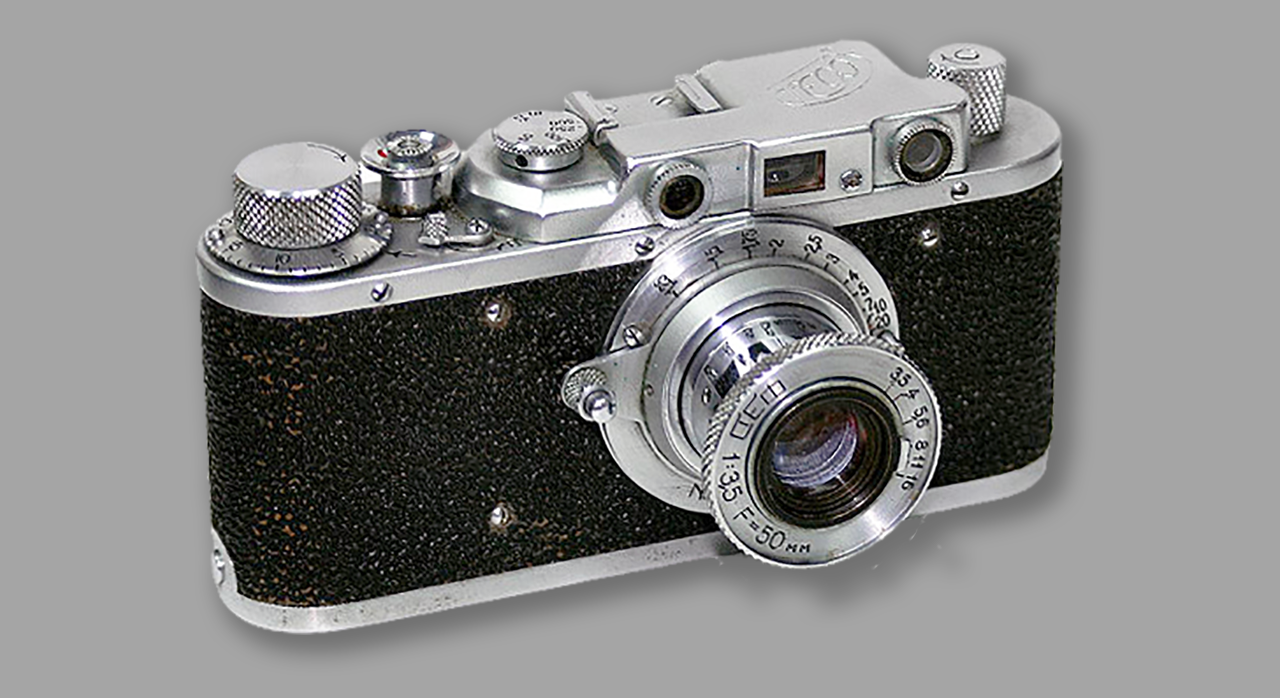
Fed1-G + FED-Lens 1:3,5 f=50mm
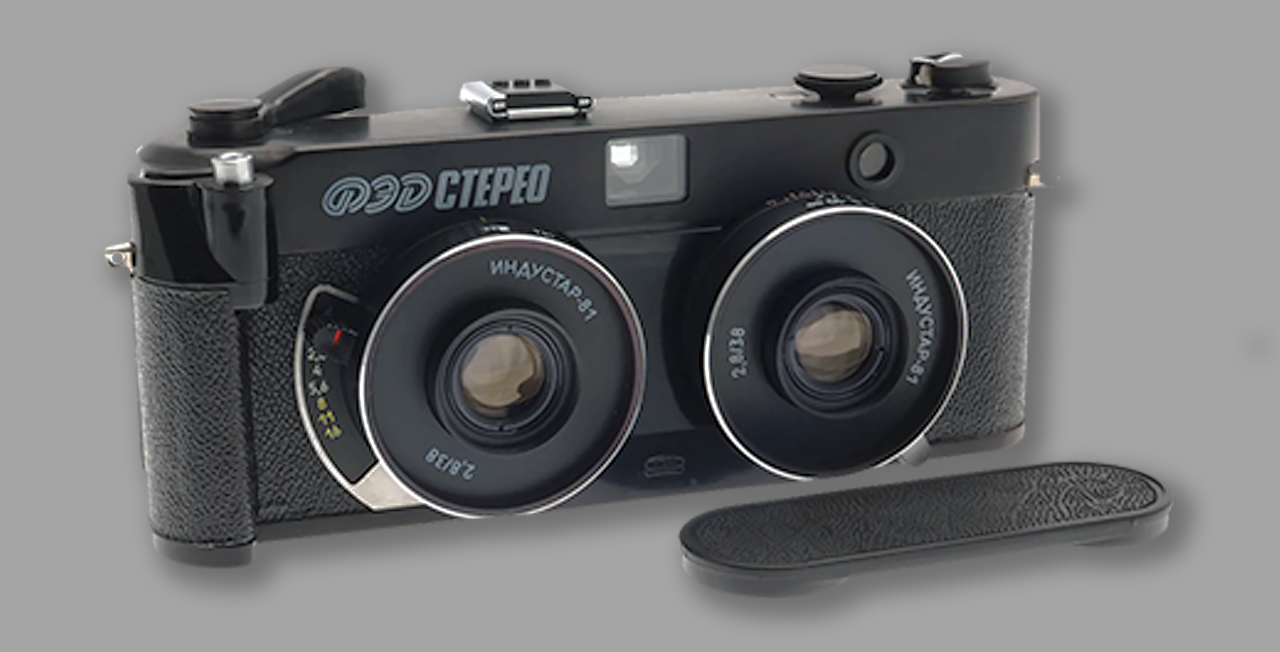
The FED Stereo is a 35mm film stereo camera produced between 1988-96.
Rangefinder Cameras
- FED 10
- FED 11
- FED Atlas
Rangefinder Cameras
- FED NKVD
- FED S
- FED 1
Rangefinder Cameras
- FED 2
- FED 3
- FED 4
- FED 5
- FED 6 TTL
- TSVVS (real name: VTS VS)
- Zarya (no rangefinder)
- FED BOY Stereo
rangefinder Cameras
- FED Micron 2
- FED 35
- FED 35A
viewfinder Cameras
- FED Micron
- FED 50
The story of the firm producing photographic cameras, FED, is closely linked to that of one man, Anton S. Makarenko, a teacher, poet and writer (1888 -1939). The history of the FED working commune is in fact a summary of the post Bolshevik revolution years in the USSR.
This joint history is comprehensively described, commented and illustrated in a highly documented study, by Oskar Fricke, published in the “History of Photography”.
- September 1920. First Ukrainian Rehabilitation Colony for “young orphans of the revolution” at Poltava under management of Anton Makarenko.
- The Leica-1-appears at the Leipzig fair.
- Death of Felix Edmundovich Dzerjinski, founder of the Soviet Secret Police, the “Tcheka”. The Ukrainian political board decided to create a “working commune for children” in the suburbs of Kharkov and to give it the name of the “‘late lamented chief”, F. E. Dzerjinski.
- June 1927. Anton S. Makarenko is “invited” by the Ukrainian police to supervise the organization of the completely new Working Commune of F. E. Dzerjinski name. He remains as its director for 8 years.
- 29th December, 1927. Official creation of the FED Working Commune, made up of 150 girls and boys between 13 and 17 years supervised by a nucleus of 50 “senior members” from the Gorky Colony.
- Government directives forbidding the importation of foreign materials.
- Stalin, launches the first five year plan. The objective is to transform an essentially agricultural country into an industrial nation, independent from the “capitalist world”.
- End of 1929. The working commune has developed several types of craft industry: carpentry, ironwork, cobbling and sewing. The products sell well and the communards receive their first salaries.
- May-November 1931. Using the profit from their sales and with the help of a state loan, the business takes an active part on the construction of new buildings, on two floors, to be used for the mass production of portable electric drills.
- January 1932. Inauguration of the buildings. Assembly of the first FD-1 drills, copies of an Austrian Assembly drill. FD, of course for Felix Dzerjinski.
- June 1932. Two other models of drills, the FD-2 and FD-3, copies of the American Black & Decker are put into production with 11,500 drills planned.
- April 1932. Launch of the Leica II in Leipzig.
- June 1932. In parallel with the production of the drills, the construction of a Leica type camera is planned. The code name is F. On 26th October the first 3 “Soviet Leicas”, exact copies of the Leica 1a are assembled.
- This year is devoted to the planning and preparation of the production of cameras, whilst the production of drills increases. Nothing, like this copy of the Leica, has ever been mass produced in the field of optics in the USSR before.
- New buildings were erected to protect the manufacturing department. Plans are made to produce 30,000 cameras per year. Only 30 FED copies of the Leica 1 will be made. To this day, none have reappeared.
- In January 1934, the production of the FED 1 started, a copy of the Leica II. The first 10 “standard” FED were assembled, numbered from 31 to 40, at the end of January. An extraordinary achievement less than 18 months after the presentation of the Leica “Complex” at the fair in Leipzig, the prestigious camera is copied and mass produced by a “group of young lads and lasses” aged about twenty.
- In December 1934 1,800 cameras were delivered (type. 1a).
- 1935 In July Makarenko is transferred to Kiev. In January 1937 he retires to Moscow in order to write, until his death on 1st April, 1939.
- September, 1935: the 10,000th FED was assembled.
- November, 1936: the 25,000th FED was assembled.
- The first accessories appear at the end of 1937, in the form of a photo-electric cell, a strange self-timer with a positioning mirror, and laboratory material.
- In November 1937 a FED equipped with sportsfinder based very closely on the Leica model is presented in “Sovetskoe Foto”. One has to wait until the end of 1938 for the appearance of the additional lenses requested by many:
– The wide-angle lens f4.5/28mm and its viewfinder.
– The f2/50mm.
– The f3.5/50mm reproduction.
– The f5.9/100mm and its viewfinder (advised aperture for usage: 6.3 replaced by the f6.3/100mm). - Announced in 1937, the new model “FED V” only actually appeared in 1938. Identical to the standard FED it displayed, like the Leica IlIa its model, the slow speeds on the front (1s – 1/20s) and the maximum speed was brought up to 1/1000s. Only 40 copies of the FED V were to be assembled.
- In 1939, two historical events were reported on the FED covers (FED 1e):
– The Ukraine lost its independence: the engraving NKVD UkSSR became NKVD SSSR, and
– the FED commune became a KOMBINAT, (from the English Combine, and the French Association) an economic structure more in keeping with the industrial complex that the firm had become: the case was engraved likewise. - The 80,000th FED was announced in the January 1939, as having been assembled at the very end of 1938.
- The 100,000th FED was celebrated by the press in its own turn in the middle of 1939.
- In 1939, the total Soviet production of all models exceeded 478,000 cameras of which 34,000 were made at Kharkov.
- On 22nd June, 1941, breaking the German-Soviet pact, Nazi Germany invaded the USSR. In the face of the German advance, Stalin ordered more than 1,300 businesses to withdraw with all their machinery into the Ural or into Siberia. From 5th September to 16th October the FED Kombinat was evacuated to Berdsk, 40 kilometers from Novosibirsk.
- Under the supervision of the Soviet Air Force, the evacuees from Kharkov were appointed to the tasks of making aircraft parts, carburettors, injection pumps (Lavotchkin LA-5 plane) etc.
- 25th October 1941: Kharkov fell to the German troops. The town was all but razed and in the destroyed FED factory, the conquerors were surprised to find copies of “Leica” and “Leitz” microscopes. The archives of the Commune were burnt, only those of the “Party” were cleared out. After long fierce battles, Kharkov was freed on 23rd August 1943 by the Red Army. Immediately, a number of volunteers, formerly from FED, returned between 1943 and 1945 to Kharkov, a town in ruins.
- In June 1945, orders to resume the photographical production arrived in Berdsk.
- In January 1946 3 workshops were set aside for this purpose. It was using bodies and lenses remaining from the evacuation and the experience of a few evacuated. In July 1945 the rather clumsy production and assembly of the first “post-war FED” began. (FED 1e) A few hundred cameras were made.
- During the first quarter of 1946, the 3.5 lenses were produced once again.
- In 1946 FED abandoned its status of Kombinat and became an independent factory.
- July 1946, the decision was made to go back to Kharkov. Already between September 1943 and 1945, some people had returned to Kharkov, with the mission of rebuilding the factory.
- From September to November 1946 9 trains coming from Berdsk brought survivors, machine tools and … a great deal of hope to Kharkov.
- In January 1947 the machines were assembled and the factory received the order from the ministry to recommence the production of cameras on a massive scale. This production started properly in March 1947. With the return of the demobbed soldiers the workforce was complete again.
- In 1947 the “FED-ZORKI” was put into production in Krasnogorsk near Moscow.
- At the beginning of 1948 the factory made 800 sets of production equipment but it was only in June 1948 that with difficulty the first twenty new FED “Kharkov” were assembled.
- In December 1948 production reached 300 FED per month. The first 1800 bodies were engraved on the cover with the Order of the Red Flag for Work. The engraving NKVD was replaced by that of NKAP. (People’s Board for the Aeronautical Industry.)
- 1952 saw a crisis, the cameras were not selling so well…
- From 1933 to 1941, then from 1946 a 1955, more than 700,000 FED “Leica copies” were made, all the same in appearance if differences in the engraving are excluded.
- Another successor of the FED 1 was to make its appearance in 1955: the FED 2. By 1970 almost 2 million had been made.
- In 1971, the factory became the FED Unit of Mechanical Production. Throughout its history FED had been, and remained, a factory producing popular photographic cameras, which were mainly mechanical and cheap but reliable.
All the attempts to break away from this ethos had not been pursued, probably more as a result of the “factory spirit” rather than external factors or technical difficulties. - From 1981 to 1985 the production general manager was called V. P. Makarenko, a famous name there.
- In 1991 after the collapse of the USSR, FED became an independent Ukrainian factory.

FOUNDER: UNKNOWN
COMPANY NAMES:
1882: SIPE – Società Italiana Prodotti Esplodenti (Italian Society of Explosive Products; ± 1917: renamed to FILM (Fabbrica Italiana Lamine Milano); 1923: FILM Ferrania; 1932: FILM Cappelli-Ferrania; 1935: cameras went to a subsidiary company, namely the Società Anonima Cameras Ferrania; 1964: Ferrania-3M; 2006: Ferrania Technologies; 2013: Film Ferrania.
COMPANY ADDRESSES:
1882: Cairo Montenotte, Liguria region of Italy; 1923: Ferrania.
Even if the production of cameras was for Ferrania to complement the sale of sensitive material, collecting these photographic devices and the material connected to them remains an activity that can give great pleasure and stimulate considerable interest by suggesting various possible trends to follow.
The story of Ferrania began in 1882 when the Società Italiana Prodotti Esplodenti (Italian Society of Explosive Products), better known by the acronym SIPE, factory was built on the banks of the Bormida River in the village of Cairo Montenotte in the Liguria region of Italy. The plant gained prominence during World War I when Tsar Nicholas II used SIPE to produce nitrocellulose-based explosive powders.
After the “Red October” Soviet revolution of 1917, SIPE was left with huge stockpiles of nitrocellulose and no customers so the factory’s focus turned toward the production of celluloid (nitrocellulose plus camphor) – the material that forms the base of photographic film. SIPE renamed themselves FILM (Fabbrica Italiana Lamine Milano) and teamed up with the legendary French Pathé Brothers, who were Europe’s largest producer of photosensitive materials.
In 1920, testing began on the first cinema films – but FILM was unable to produce an economically viable product for several years. However, it took a couple of Frenchmen, Charles and Emile Pathé, at the time Europe’s largest film distributors, to produce a viable product. But after a few years, when they feared their efforts would not be profitable, the Pathé Brothers sold their shares in the company to Credito Italiano, a bank that earned a reputation for bailing out similar companies, like the struggling Milan-based glass plate manufacturer, Cappelli.
Upon the departure of the Pathé-Brothers in 1923, and under the new ownership, engineer Franco Marmont was installed as President and Chief Executive Officer of the company now known as FILM Ferrania, referencing the tiny village the new factory now called home.
Franco Marmont began to turn the company around – first by lowering prices (initially at a loss), and then reducing production costs. They also produced some cameras as well and were also involved in various other areas related to photography such as printing. Sales flourished.
In 1924, Ernst Leitz released the first Leica cameras, effectively ending the age of glass plates and turning celluloid-based film into a mass-produced, global commodity in a very short period of time. FILM Ferrania rode this wave, expanding to produce X-ray, 16mm cinema, and many roll film formats like 120 and 35mm.
In 1932, FILM was turning impressive profits, enough to acquire the Cappelli company, a Milan manufacturer of glass plates. For a brief period, products were marketed and sold as FILM Cappelli-Ferrania. FILM Ferrania also expanded its cinematic base to include cameras. The Cappelli partnership ended within a few years, but the factory continued to flourish, eventually becoming one of Milan’s largest employers with a workforce well exceeding 500.
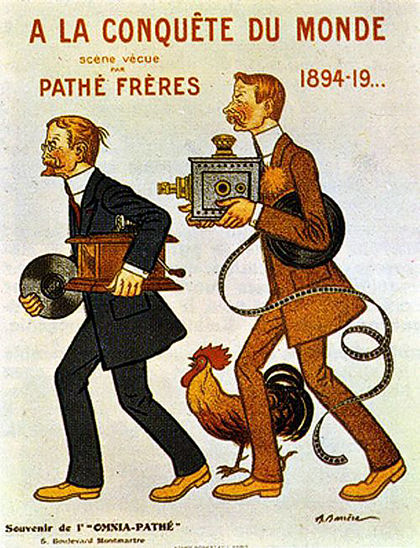
French advertisement for the Pathé Brothers
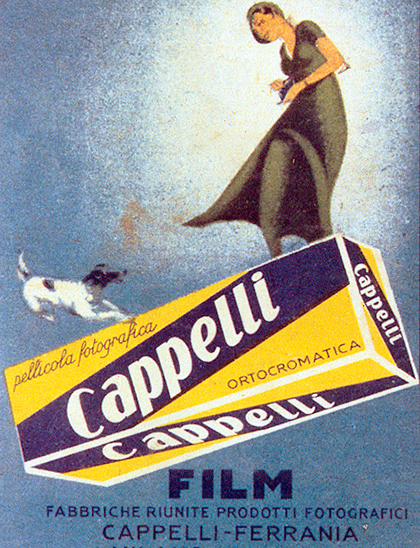
Advertisement from the Cappelli era
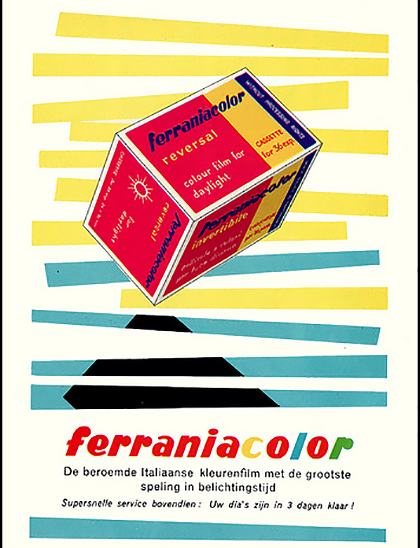
An early German Ferraniacolor advertisement
By 1935, Ferrania purchased FIAMMA, manufacturer of amateur box cameras and brought it in a subsidiary company, namely the “Società Anonima Cameras Ferrania”. For a brief period products were marketed and sold as FILM Cappelli-Ferrania. In 1936, camera production began in Cappelli’s Milan factory and for many years thereafter, they were known as both a film and camera producer. Some of these cameras were among the most beautiful and interesting of the time and are now sought after by amateurs and collectors from all over the world.
Ferrania branded and not manufactured most of its cameras. It is known to all that the company did not internally produce all the cameras it had in its price lists, indeed the more technically complex, and therefore often more interesting, were built by other companies.
For the camera supply Ferrania relied above all on national manufacturers, then it used foreign companies partly due to the absence of possible Italian partners; only the construction of the simplest appliances remained within the group.
By 1938, ownership had changed a couple more times, the company was renamed Ferrania, and the Cappelli connection dissolved – but the factory grew to occupy over 90,000 square meters with a staff of more than 500.
Like many of its counterparts, it supported the war effort with film-based products. Through much of the 30s and 40s, Ferrania film was a nearly obligatory “choice” for most directors due to the fascist government and their autarchic policies. The movies made during that time period were unrealistically positive, with opulent productions and fanciful characters.
As time progressed, a new breed of Italian filmmakers shrugged off the old ways of Italian filmmaking, opting for a gritty, urban style called Neorealism. These directors remained loyal customers of Ferrania not because they had to, but because they loved the film. Neorealism eventually faded as a style, but still had an enormous global impact.
All the great Italian directors of the mid-twentieth century, remained true to Ferrania for it’s quality and flexibility. The big names of Italian cinema – Pier Paolo Pasolini, Vittorio De Sica, Roberto Rossellini and Federico Fellini – are all permanently linked to Ferrania.
The best-known Ferrania film stock from that era is the legendary P30 black and white film. This film was the subject of a massive advertising campaign in the United States in the wake of Sophia Loren’s 1960 Academy Award for the film Two Women, directed by Vittorio De Sica. Ferrania’s popularity multiplied in 1963 with two more Oscars for 8½ by Federico Fellini and starring Marcello Mastroianni and Claudia Cardinale, and shot on P30.
Demand was so enormous that Ferrania produced 35mm and 120 versions of P30 so that non-professional photographers could “feel a bit Fellini,” with their still photo cameras. It was a huge commercial success.
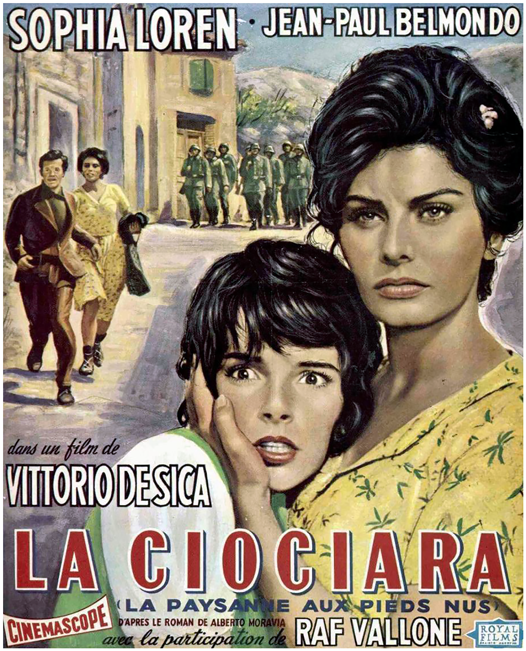
The first colour emulsion, Ferraniacolor, dates back to 1952, and was pretty much hated by directors of photography for the lack of sensitivity in its early versions. Ferraniacolor would require several more years to perfect and finally get to the level of the primary competitors, Agfa and Kodak.
By the the mid-60s in Italy, Sofia Loren, Gina Lollobrigida and Claudia Cardinale were known globally as Italian sex symbols. Rossellini, De Sica and Fellini had cemented their legendary status. Ferrania was synonymous with photography and cinema.
- 3M 1033-x
- 3M 1073-x
- 3M 1014
- 3M Euramatic
- Alfa
- Astor
- Box Camera
- Condor I & Ic
- Condor II
- Condor Junior
- Condoretta
- Delta
- Elioflex
- Elioflex 2
- Eta (version 1)
- Eta (version 2)
- Eura
- Eura Rapid
- Euralux 34
- Euralux 44
- Falco S
- Filma
- Ibis
- Ibis 34
- Ibis 44
- Ibis 6/6
- Lince 2
- Lince 3
- Lince Rapid
- Lince Super
- Lince Super T
- Rondine
- Tanit
- Veramatic
- Zephir
- Zephir 2
- Zeta
- Zeta Duplex
- Zeta Duplex 2
- Imation Color HP100
- Imation Color HP200
- Imation Color HP400
- Scotch Color 100 AT
- Scotch Color 200 AT
- Scotch Color 400 AT
- Scotch Color 100 EXL
- Scotch Color 200 EXL
- Scotch Color 400 EXL
- Ferrania Solaris FG100
- Ferrania Solaris FG200
- Ferrania Solaris FG400
- Ferrania Solaris FG400i
- Ferrania Solaris FG800
- Ferrania Solaris FG800i
- Ferrania Solaris FG Plus 100
- Ferrania Solaris FG Plus 200
- Ferrania Solaris FG Plus 400
- Ferrania Solaris FG Plus 800
- Imation Chrome 100
- Imation Chrome 400
- Imation Chrome 600T
- Scotch Chrome 100
- Scotch Chrome 400
- Scotch Chrome 1000
- Ferrania B&W Pancro (P30 film was continued by the company Film Ferrania)
- Ferrania B&W Superex Panchro
All pictures in this column come from the Ferrania Film Museum.
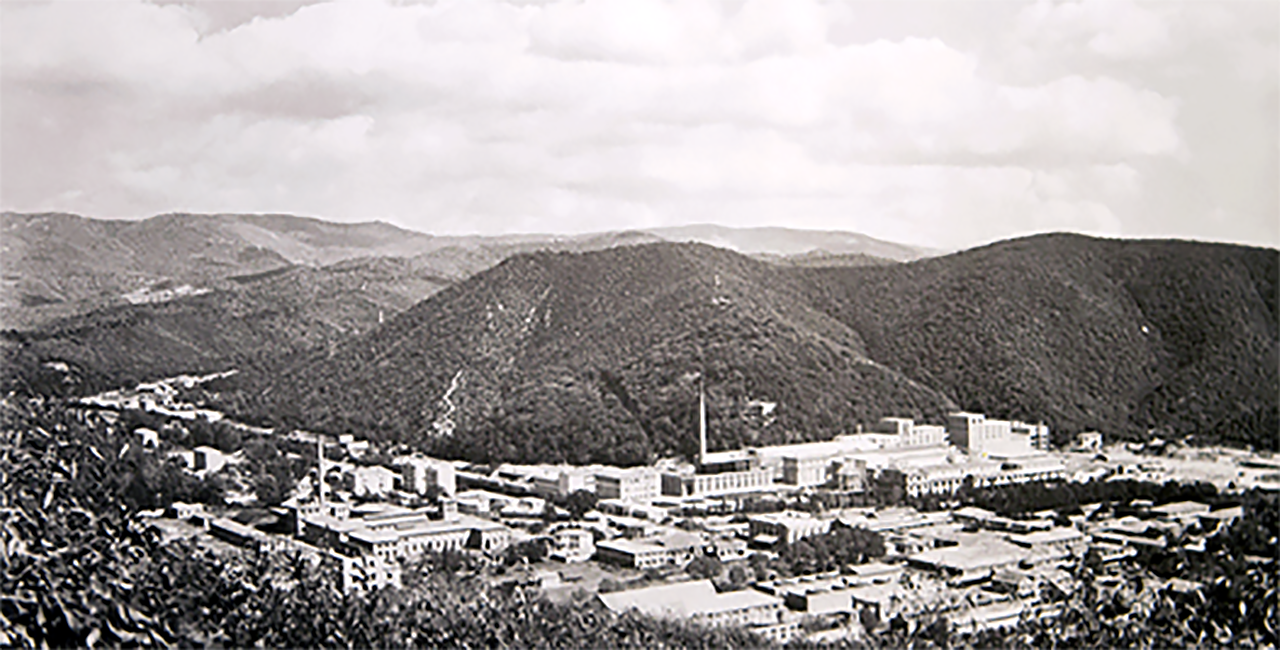
The old SIPE factory built on the banks of the Bormida River in the village of Cairo Montenotte in the Liguria region of Italy.
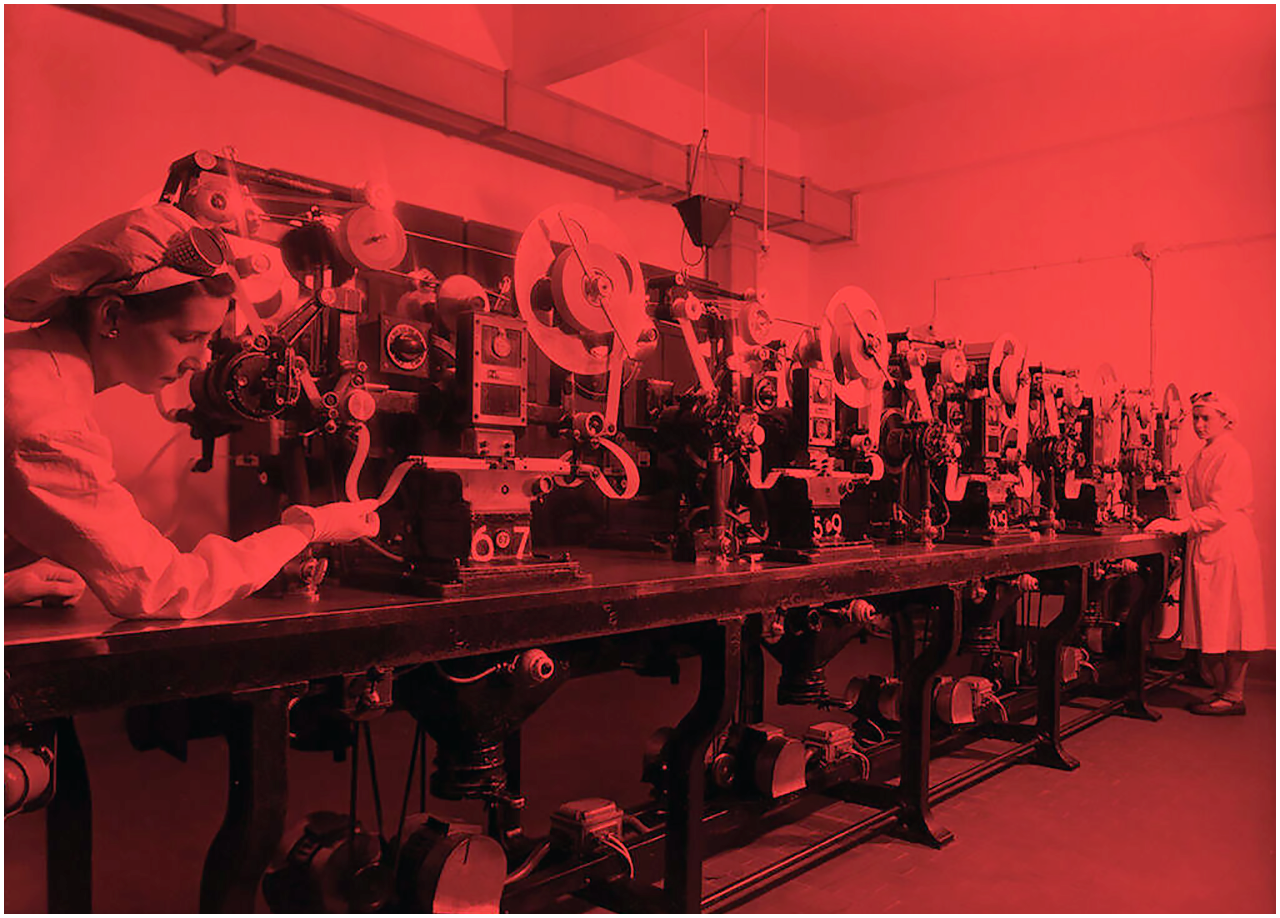
The perforation of the film took place – of course – in the dark or under red light.
After World War II the golden age of Ferrania truly began. With novice-level cameras on the market and the mainstreaming of photography, Ferrania’s production of 35mm and 120 films blossomed along with the already famous cinema products.
The commitment that Ferrania put into advertising and propaganda was important and considerable, which also led to the birth, in January 1947, of the magazine “Ferrania”; the best Italian professionals in the sector were called upon to create the advertising and propaganda material and in the editorial staff of the magazine, even today reading this material one finds oneself faced with images and texts that are still beautiful and current and one discovers the names of characters among the authors who have made the history of Italian photography and beyond.
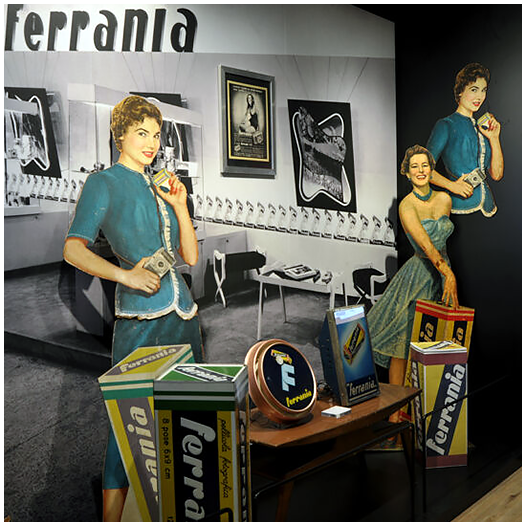
By the early 1960s, Ferrania had established an international reputation for superior film products. By the the mid-60s in Italy, almost every Italian had a Ferrania camera and film at home, and the trademark was as famous and established as Olivetti and Fiat. It is precisely at this peak of success that Ferrania attracted the attention of the 3M Corporation in America.
3M acquired the company in the 1964 which would thereafter be known as Ferrania-3M. The 3M brand and Scotch was most commonly used. Cine film was discontinued. By this time their films were mostly store branded films bearing “Made in Italy” as the only indication.
The factory received a complete upgrade, and research, development, and training increased dramatically during this period. The results included high-speed X-ray films and daylight-balanced colour transparencies. Eventually, the company dropped “Ferrania” from its name, and doing so seemed to mark a downturn in its fortunes. Unable to complete with the dominant film markets like Agfa, Fujifilm, and Kodak, 3M relegated the Ferrania plant to manufacturing 35mm films.
In 1995, a depressed economy resulted in major 3M corporate shakeups that included restructuring the Italian Ferrania and American Imation companies into a single entity. Within four years, Ferrania was sold off to an Italian investment company, which tried to reinvent itself by focusing on pharmaceuticals and solar technology, and the Ferrania name returned.
In 2006, Ferrania was restructured into Ferrania Technologies, which concentrated primarily on pharmaceutical products, and a solar panel division called Ferrania Solis. In October 2012, the company fired almost all of their employees, after they had already stopped film production in late 2009. In 2013, the successor company Film Ferrania acquired Ferrania’s old production machinery with the purpose to restart film production.
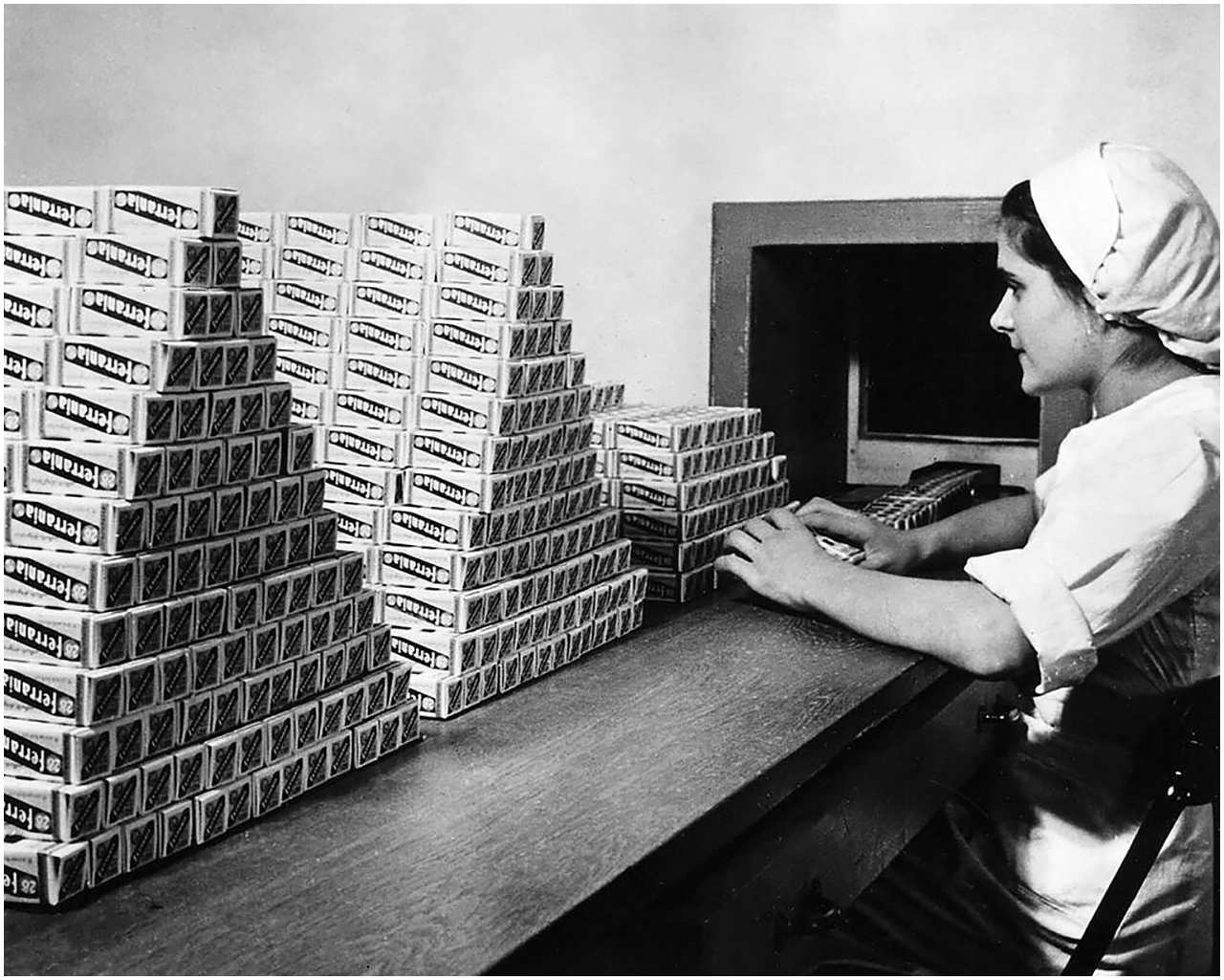
Stacks of Ferrania films stacked in “Toblerone Style”
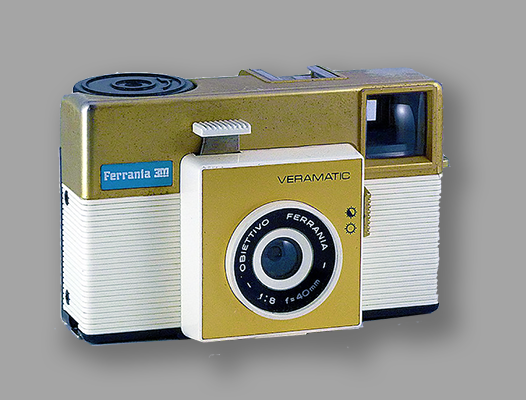
The Veramatic Camera was manufactured by the Ferrania – 3M company in circa 1964. This camera was constructed of plastic with a built-in eye-level viewfinder and flash mount and used no. 126 Instamatic film cartridge. The Veramatic Camera was available in five different two-tone models: black/gray, white/gold, pink/green, orange/blue, pink/green.
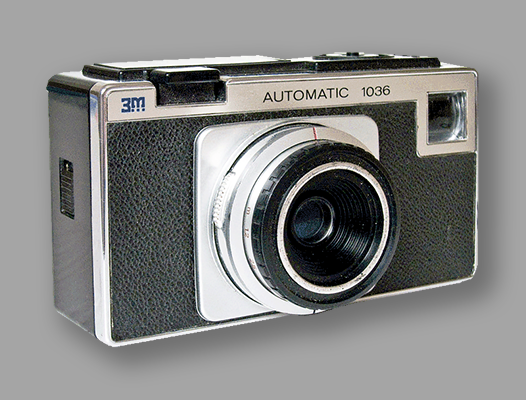
The 3M Automatic 1036 camera was manufactured by the 3M company in Milan, Italy in circa 1971. This inexpensive camera was constructed of plastic with a fixed focus plastic lens. The simple point and shoot camera accepted 126 film cassettes and square Magicube falsh bulbs.
COMPANY NAMES:
1930: Fisher-Price; 1969: The Quaker Oats Company bought Fisher-Price; 1991: Fisher-Price regained its independence; 1993: Fisher-Price became a wholly owned subsidiary of Mattel.
COMPANY ADDRESSES:
1930: East Aurora, New York;
Fisher-Price is an American company that produces educational toys for infants, toddlers and pre-schoolers.
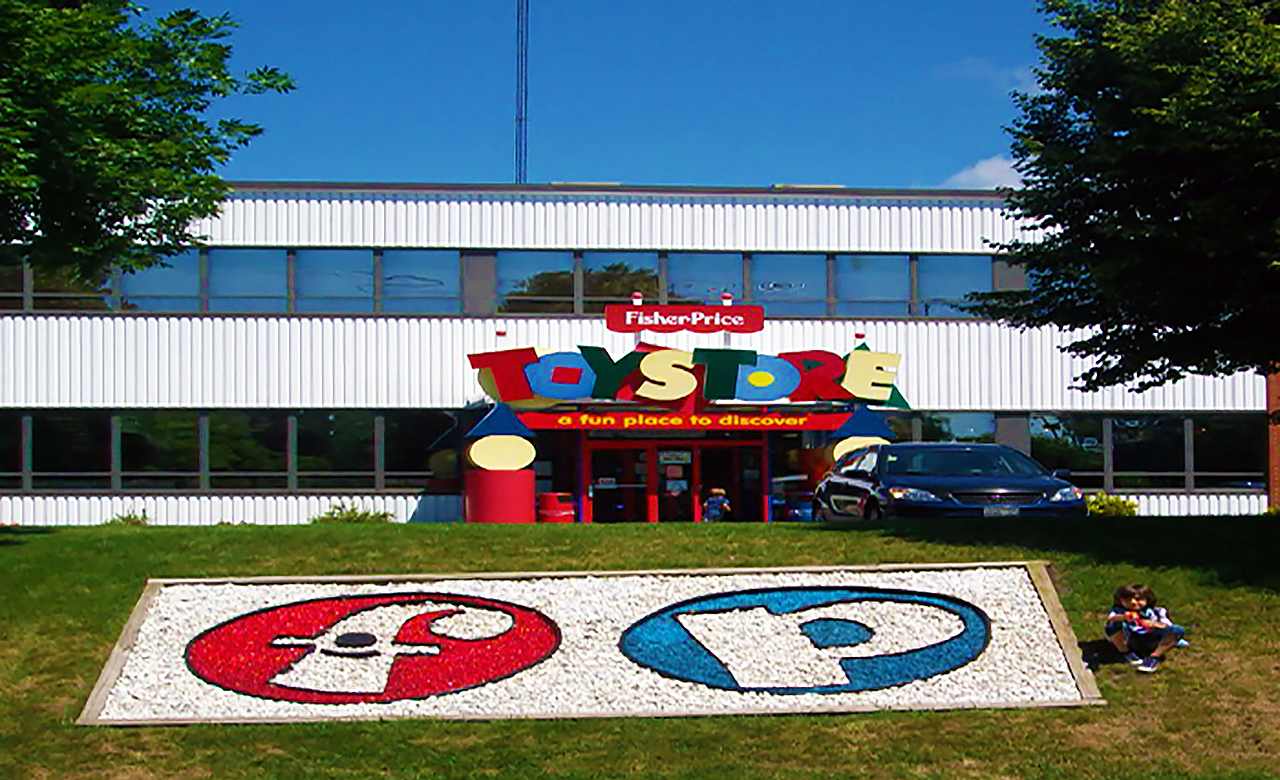
The Fisher-Price headquarters in East Aurora, upstate New York, which employs around 750 people.
Founded in 1930 during the Great Depression by Herman Fisher, Irving Price, Price’s illustrator-artist wife Margaret Evans Price, and Helen Schelle, the name Fisher-Price was established by combining two of the three names. Fisher worked previously in manufacturing, selling and advertising games for a company in Churchville, New York. Price had retired from a major variety chain store, and Helen Schelle previously operated Penny Walker Toy Shop in Binghamton, New York.
Fisher-Price’s fundamental toy-making principles centred on intrinsic play value, ingenuity, strong construction, good value for the money, and action. Early toys were made of heavy steel parts and ponderosa pine, which resisted splintering and held up well to heavy use. The details and charm were added with colourful lithographic labels. Mrs. Price was the first Art Director and designed push-pull toys for the opening line, based on characters from her children’s books.
The mayor of Aurora, New York, supported Fisher by raising $100,000 in capital. In 1931, three of the four founders took 16 of their wooden toys to the American International Toy Fair in New York City and they quickly became a success. The first Fisher-Price toy ever sold was “Dr. Doodle” in 1931.
In the early 1950s, Fisher-Price identified plastic as a material that could help the company incorporate longer-lasting decorations and brighter colours into its toys. “Buzzy Bee” was the first Fisher-Price toy to make use of plastic. By the end of the 1950s, Fisher-Price manufactured 39 toys incorporating plastics.
During the 1960s, the Play Family (later known as Little People) product line was introduced and soon overtook the popularity of earlier toys. The ‘Family House’ was one of the more popular Little People play sets. Herman Fisher retired at the age of 71 in 1969 and The Quaker Oats Company bought Fisher-Price the same year.
From Quaker Oats to Mattel
In 1991, Fisher-Price regained its independence from The Quaker Oats Company and became a publicly traded company. Two years later, in November 1993, Mattel bought Fisher-Price. A new management group set the company’s focus on basic, infant and preschool products and began expansion into international markets. By 1997, Mattel decided to market all of its preschool products under the Fisher-Price name.
Fisher-Price has created approximately 5,000 different toys since the early 1930s. One of Fisher-Price’s best-known lines is Little People toys, which includes people and animal figures along with various play sets such as a house, farm, school, garage and vehicles. The figures, which originally were wooden peg-style characters, are now moulded of plastic and have detailed features.
Camera models of Fisher-Price
Of course, the range of toys at Fischer-Price is huge. However, in the context of the design and scope of this website, we limit ourselves – of course – to the various cameras that they have or had included in their program for children.
Fisher-Price has occasionally ventured into partnerships with manufacturers, including Kodak, in order to make fully-functional cameras specifically designed for children (larger grip surfaces, viewfinders used by both eyes, etc.). There have been several brightly coloured models for film and digital formats. Unfortunately, some of the models have generic names and can only be distinguished by their colour and design.
• Fisher-Price Perfect Shot™ (1997-2000)
Body: red/yellow/black
Lens: 35mm f/6.8
Binocular viewfinder, built in flash, takes two AA batteries.
• Fisher-Price Perfect Shot™ (2000-2006)
Body: blue/yellow/red;
Binocular viewfinder.
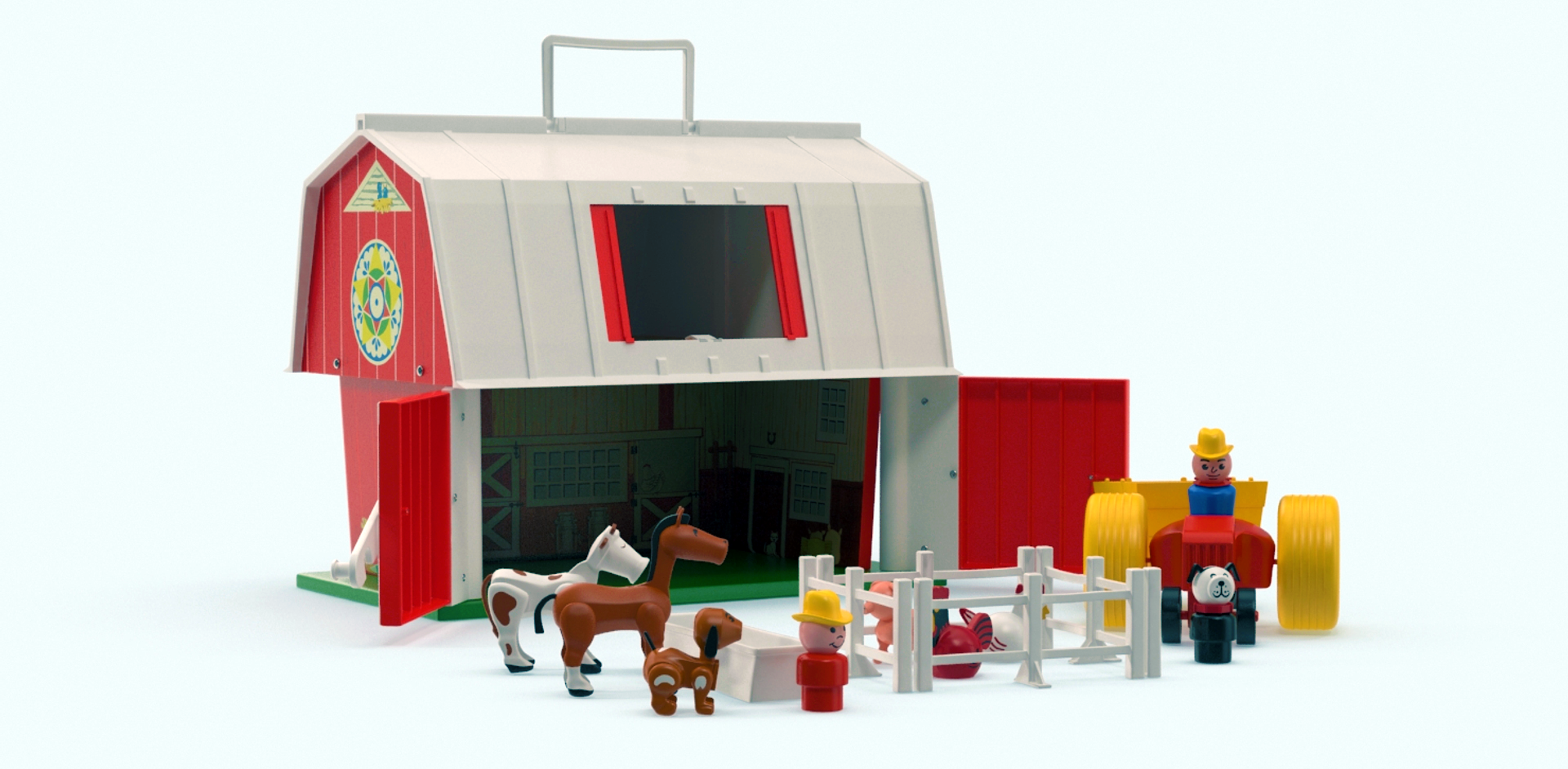
Fisher-Price Little People Farm Playset

Fisher-Price Perfect Shot™ 35mm (1997-2000)
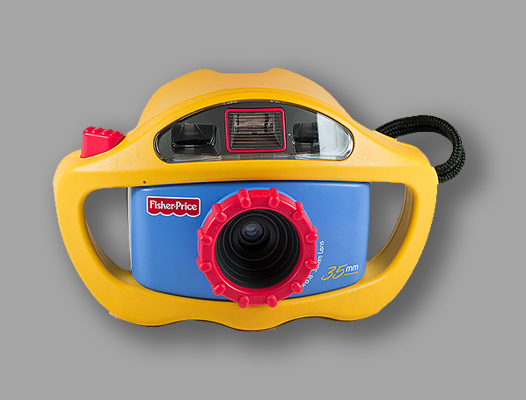
Fisher-Price Perfect Shot (2000-2006)
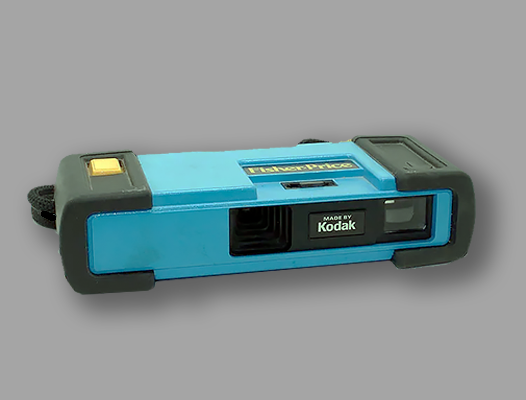
Fisher-Price Kodak manufactured Camera (1984-1987)
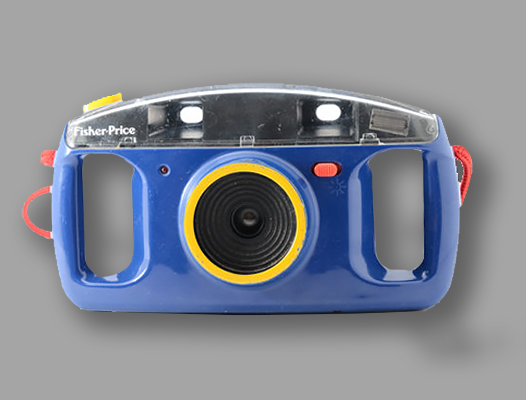
Fisher-Price Perfect Shot Blue (1994-1997)
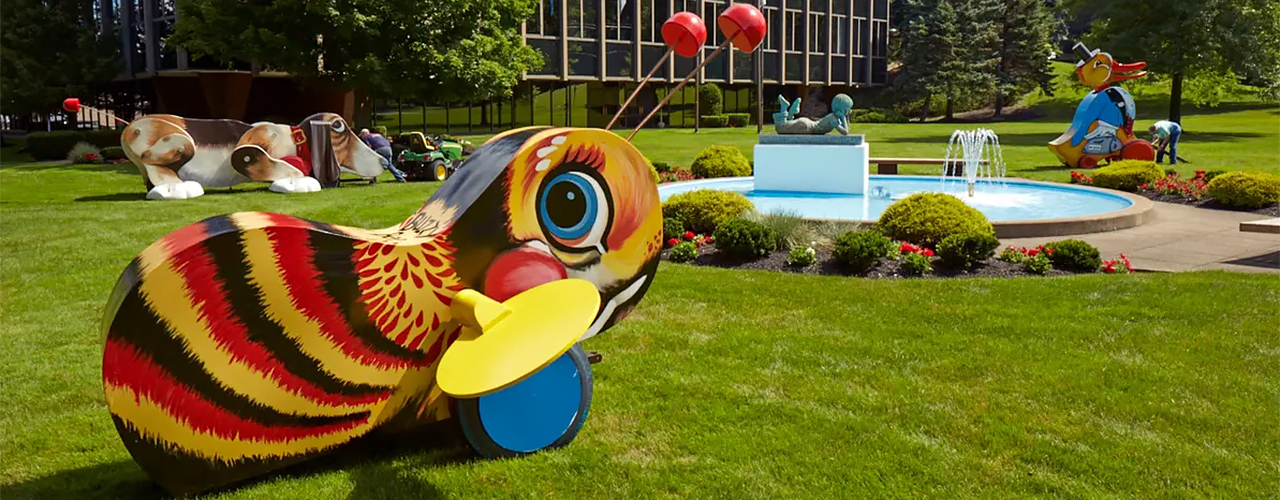
FOUNDER: Isaac Albers
COMPANY NAMES:
1924: Foto Optiek Kino Albers (FOKA); 2000: Foka was dissolved and taken over by Foto Klein. Shortly afterwards Foto Klein went bankrupt and in 2016 Kamera Express bought the historic photo shop in Kralingen. Since then, the store’s name has been Foka Superstore.
COMPANY ADDRESSES:
On the corner of Oostzeedijk and Admiraliteitsstraat, Rotterdam.
Fodor was a Dutch distributor of photographic equipment based in Rotterdam. It was founded in the 1920s; they imported German and Japanese equipment from the 1950s, some of which was rebranded under the Fodor name.
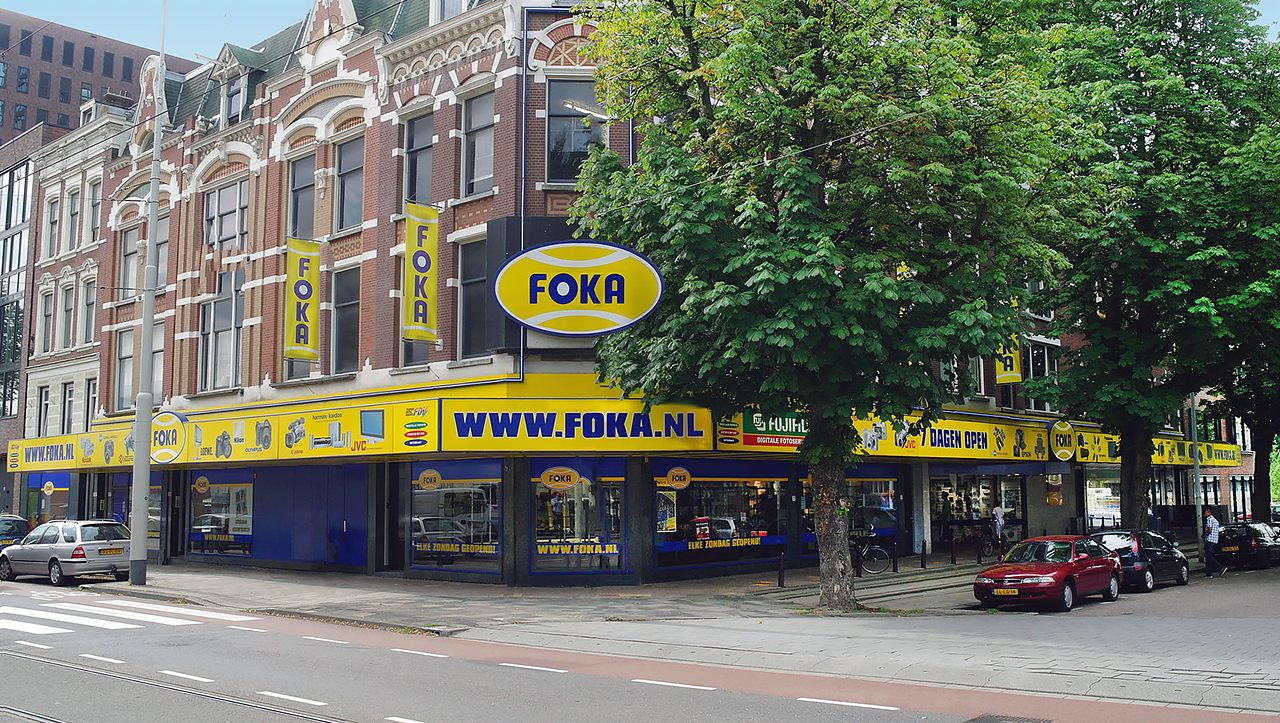
The Foka-shop at the corner of the Oostzeedijk/Admiraliteitsstraat (Hoogstraat)
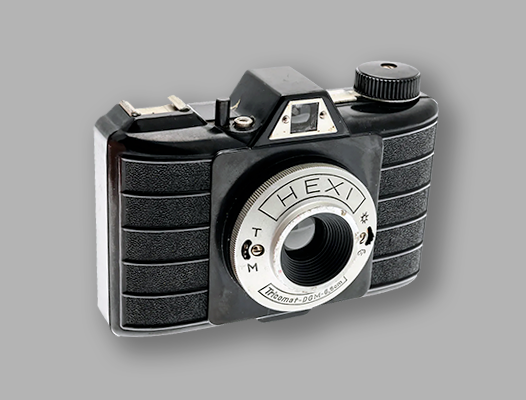
This is an Hexi camera released in 1955 by West German manufacturer Apparatebau und Kamerafabrik. It has a screw-out type fixed focus lens, a single shutter speed, and a simple bakelite body. It was rebadged as the first Fodor camera.
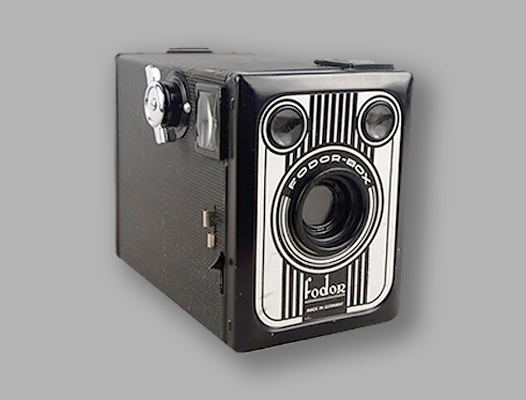
Fodor Box Camera of 1953, original was a German Vredeborch Vrede-Box Camera. Vrede-Box is a series of medium format film box cameras. A large number of cameras were made for other distributors with their own name, such as Filmor, Fodor, G-M-Box, Haaga, Helios, Hanimex, Joy-Box, Manex, Monty, N-Box, Prinz Pilot, Photopia, Regia Box, Slomexa, Texar, Union.
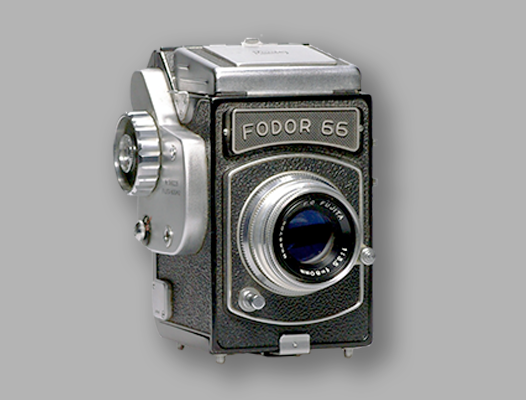
This is a Fodor 66 Single Lens Reflex camera made by Tokyo Optical Co. in Japan around 1957. This camera shoots 6x6cm on 120 roll film.
 Around 1924 Isaac Albers started the photo shop Foto Optiek Kino Albers (FOKA) in Rotterdam on the corner of Oostzeedijk and Admiraliteitsstraat. FOKA became over the years a photo shop that was also known outside Rotterdam for its high quality.
Around 1924 Isaac Albers started the photo shop Foto Optiek Kino Albers (FOKA) in Rotterdam on the corner of Oostzeedijk and Admiraliteitsstraat. FOKA became over the years a photo shop that was also known outside Rotterdam for its high quality.
In the 1950s, the Albers family founded the Dutch company Fodor. Fodor imported products from abroad. Among the imported products were student microscopes, which were marketed under the name Fodor.
Before WWII most photo products were imported from Germany. After this war, import from Japan started in the early sixties. Almost 99% of Japanese photographic and audio products entered the Netherlands through Fodor.
The wife of Mr. Albers ran the Foka photo shop in Rotterdam, which grew to the biggest of Holland. Foka imported Hortson cine-projectors and Berthiot optics from France and photographic paper of the Hungarian brand Forte. Forte was founded by Kodak in the town of Vac in the early twenties.
Isaac’s son Ed fell into photography almost automatically and initially helped out in the darkroom of the family business. The business had grown considerably after the acquisition of an adjacent piano shop, a candy store and a drugstore. The customer base also increased.
Foka attracted photo enthusiasts from far beyond Rotterdam. After Ed Albers’ retirement, the Fodor firm was dissolved in 2000. FOKA has been taken over by Klein Fotografie. Shortly afterwards Foto Klein went bankrupt and in 2016 Kamera Express bought the historic photo shop in Kralingen. Since then, the store’s name has been Foka Superstore.
| REBADGED CAMERA | ORIGINAL CAMERA | MADE BY |
|---|---|---|
| Fodor | Hexi | Apparatebau und Kamerafabrik |
| Fodor Six | Wester Atlasix | Nishida |
| Fodorflex and Fodor B | Beautyflex models | Taiyōdō |
| Fodorflex | Mananflex (unconfirmed) | |
| Fodor Record | Unknown model | Tougodo (unconfirmed) |
| Fodor 35 | Taron 35 | Nippon Kōsokki |
| Fodor C-35 | related to Meikai C35C and Meikai EL | Tougodo |
| Fodor Novo | Unknown model | Unknown maker |
| Fodor 66 | Fujita 66 | Fujita |
| Fodor-Box | Vrede Box | Vredeborch |
| Fodor-Box Synchrona | Vrede-Box Synchrona | Vredeborch |
1945: Foitzik-Kamerawerke; 1958: The company closed
1945: originally located in Lübeck, northern Germany, 1950: re-opened in Trier.
The Foitzik Company produced various 35mm film and 120 film 6 x 6 format folding cameras between 1951 and 1958.
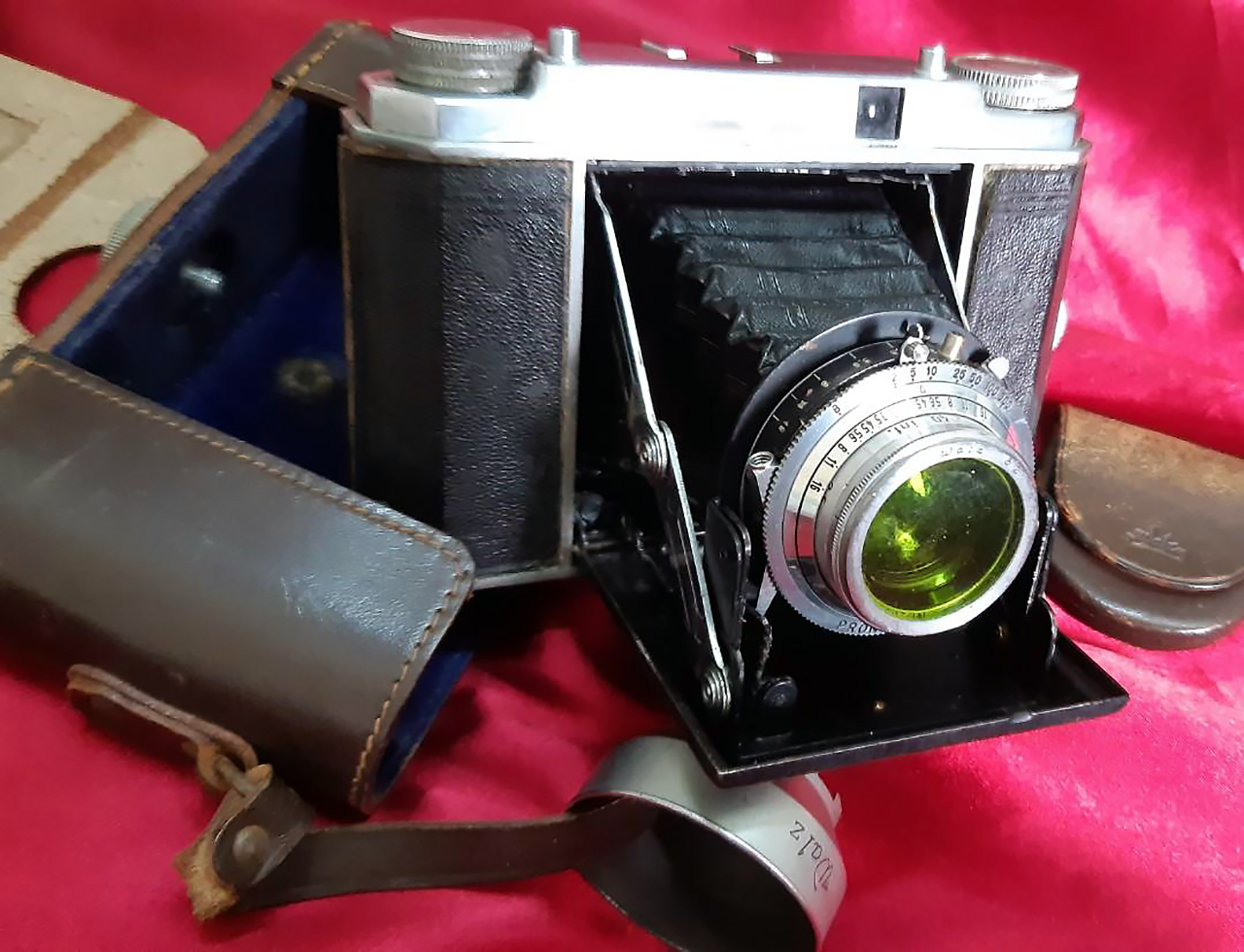
The model of the Voinix shown here is not mentioned with the designation “Visobella” in any available reference work. It was suitable for film format 6 x 6, simple front release
- Foica
- Foinix (35mm)
- Foizica
- Unca (35mm)
- Foinix (6×6)
- Foinix Ori
- Foinix Orito/Foitzik Reporter
- Foinix OS
- Mess-Foinix (rangefinder)
- Unca (6×6)
The economic miracle in Germany (Marshall Plan) after WWII developed many smaller camera manufacturers. In the euphoric mood after the end of the war about 70 new camera factories were founded in West Germany of which many have been forgotten today. For example, the lens manufacturer Heinz Kilfitt in Munich, Adox, as a camera maker, from Wiesbaden, etc.
One of those forgotten pioneers was Karl Foitzik, the founder of Foitzik-Kamerawerke that between years 1951 and 1958 manufactured a variety of handy and predominantly inexpensive cameras which were exported over 60 countries. In 1909, Karl Foitzik was born as the fifth son of the mining employees Joseph Foitzik in Schomberg in Bytom/Upper Silesia. After studies of mechanical engineering Karl Foitzik practiced six months at Carl Zeiss Jena. During this time, he took the decision to establish a camera factory of his own.
The Foitzik-Kamerawerke were founded in 1945 in Lübeck, northern Germany. There the company could make 600 units of its early camera types Foica, Foizica and Unca. It had troubles with the quality of the Steinheil lenses. In 1950 the factory got a friendly and enthusiastic acceptance in Trier and here the factory was reopened with 20 employees.
The Trier Period
According to various sources, the production in Trier began in 1951 and ended in 1958. Karl Foitzik himself took part in the development of cameras. Foitzik produced several camera models and some accessories, a self-timer, two rangefinders and a universal viewfinder. In 1953 the takeover of Optische Werkstätte Janetzki enabled Foitzik to produce its own lenses. The lenses are marked with their name ‘Foinar’ and the place of manufacture (Trier). Coated lenses are marked ‘AR’ (Anti Reflektierend). In its heyday the company employed about 170 people.
Actually, the company was caught between the higher quality of other German firms and the cheaper cost of comparable Japanese models, although the “Made in Germany” marking generated some sales. Vintage Foitzik cameras are uncommon.
Warehouses Kaufhof and Quelle sold Foitzik’s camera, exports went to 60 countries. The company was closed in 1958, but the decline already began 1955 with Foitzik’s sudden death in a car accident in Simmern, in bad weather. His wife Margarethe led the company until it was closed in 1958. Another reason to cease the production was the strongly increasing Japanese competition.
Below are four cameras from Foitzik’s production program, complete with a brief description.
FOUNDER: Carl Friedrich Foth
COMPANY NAMES:
1926: C.F. Foth & Co; The company was dissolute in the early 1940s.
COMPANY ADDRESSES:
1924: Weidengasse 35/38, Danzig ; 1926: Knesebeckstrasse 111-112, Berlin-Neukölln; 1926-1928: Cottbusser Damm 25-26, Berlin; 1928-1932: Berlin-Britz Grade Straße 91-107; 1932-1940: Berlin-Buchholz, PankStrasse 1-3.
Foth is known to have produced, or distributed binoculars and other optical instruments and manufactured a range of cameras and lenses from 1926 to 1940. Foth cameras were relatively inexpensive and were sold in Europe, the United States, Australia and Japan. Well-known distributors were Peeling & Van Neck Ltd. (London), Fotet Camera & Co. (London), A. Maillard (Paris). Burleigh Brooks Inc. (New York), Nichizui Boeki K.K (Tokyo), Asanuma Shōkai (Tokyo).
Carl Friedrich Foth, descendant of a Dutch family, started a workshop for optical instruments at the end of the 19th century. The family name Foth is common in cities on the south coast of the Baltic Sea. Probably a corruption of the Dutch ‘voet’. It is common knowledge that many Dutch people moved to this region in the 16th century and later.
In 1924 he opened an optical workshop in Danzig in the former Danziger Gewehrfabrik, Weidengasse 35/38. In that workshop he produced binoculars, microscopes and also radios and headphones. No copies are known about radios from Foth, but examples of headphones (2000 Ω), microscopes and binoculars (6x, 8x and 12x) are.
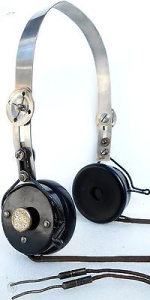
C.F. Foth Berlin 4kΩ Crystal Radio Set Bakelite HeadSet
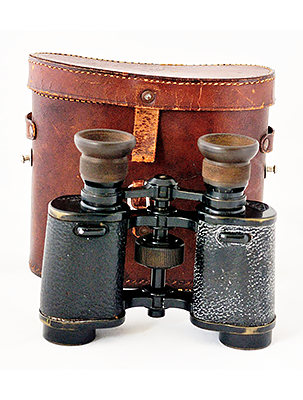
C.F. Foth & Co. Danzig 6 x 25 binoculars (1924).
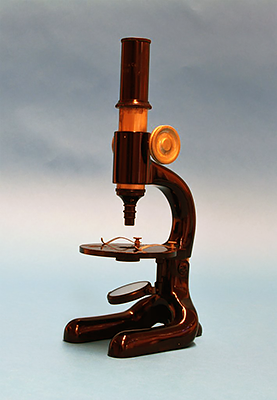
Foth Compound achromatic microscope, ca. 1925.
In the telephone books from 1924 – 1926 Carl Foth is mentioned as director, who lived at 22 Röpergasse in Danzig. Who the partner (& Co.) was, is not yet clear. Possibly the factory is a continuation of a factory that was previously located in a part of the former German Empire, which was no longer German territory after 1919.
Danzig has been a free city since August 1920 (free city Danzig (1920-1939)) under the supervision of the League of Nations. The area bordered on East Prussia and was connected to the rest of the German Empire via the Polish corridor. Because of this isolation, the factory was moved to Berlin-Neuköln in 1926. The company would not produce its first photographic camera until around 1929 at which time they starting making a small variety of folding plate and roll film cameras.
Worldwide selling
From around 1930, Foth cameras were sold by various distributors worldwide. From 1929 to 1933, Carl Foth registered a total of seven developments in camera technology for a patent. Patents for self-timer were granted on April 24 and December 2, 1931, among others.
Many of their early cameras were 6.5 cm x 9 cm folding plate cameras, but they also made a few different 6 cm x 9 cm and 6.5 cm x 11 cm roll film models, and at least one TLR called the Foth Flex. The cameras were rarely given any kind of unique names like the “Derby” and were generally known as Foth Special, Foth Film 6×9, and Foth Film 6.5×11.
Between 1930 and 1932 it was planned to move the company as C.F. Foth & Cie to Biel in the Swiss canton of Bern. An agreement was reached with the city on this. Ultimately, however, the chronicles of the city of Biel do not report an actual relocation. Instead, the company has been registered in Berlin-Buchholz, Pankstrasse 1–3 since 1932. There, photo cameras were produced for the 127 film, 135 film and 220 film format. The Foth-Flex (220 film) and Foth Derby (127 film) are well-known. Both in various designs with different lenses.
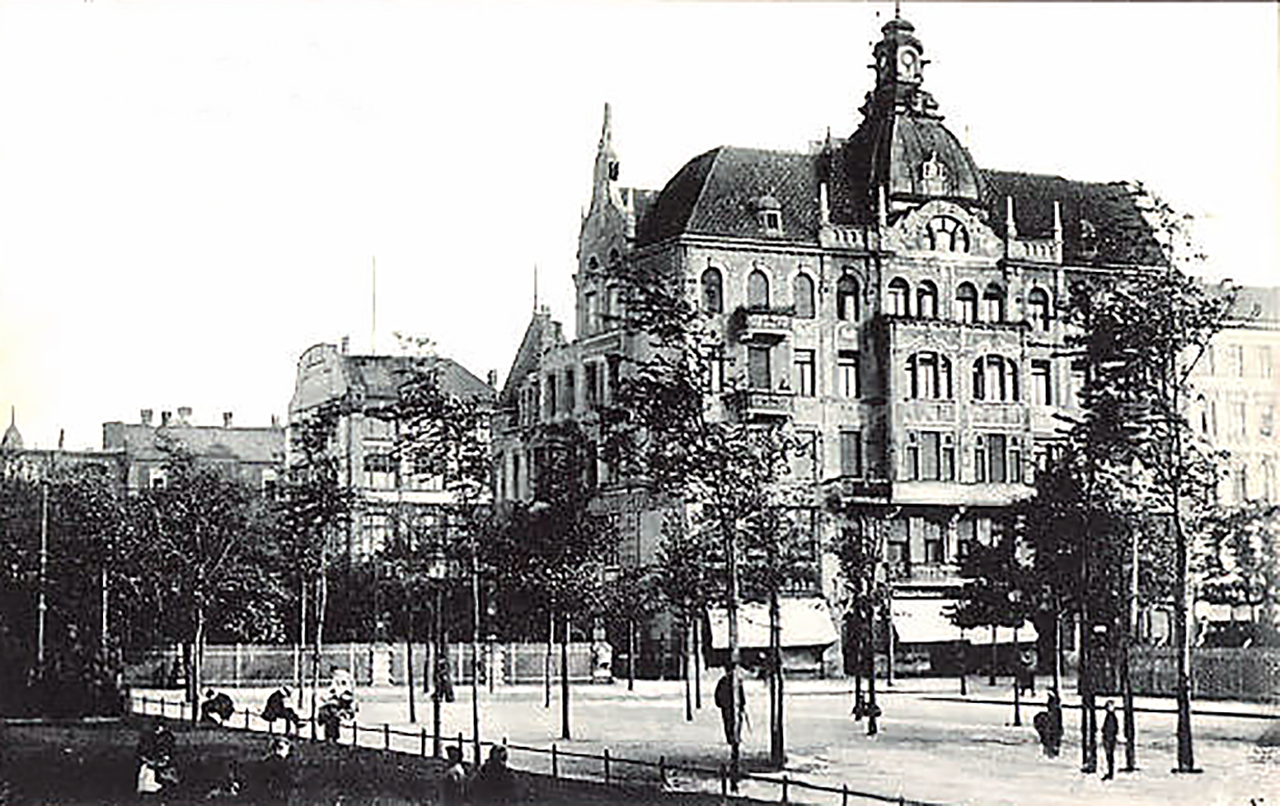
The Pankstraße in 1928
The Foth Derby
A rather basic camera, the Foth Derby was built to typical high German standards. Introduced in 1930, the Foth Derby was in production for at least a decade. The camera featured a well built focal plane shutter with a top speed of 1/500 seconds, a self timer, a body mounted shutter release, and it came equipped with either a 4-element f/2.5 Foth Anastigmat lens, or a 3-element f/3.5 lens.
When introduced, the Derby was positioned as the discount German competitor to the Leica and Contax. In 1933, the Foth Derby sold in the United States for $17.50 with the f/3.5 lens, and $26.50 with the f/2.5. When adjusted for inflation, that’s $332 and $502 today. Certainly not cheap, but it’s about 1/5th the cost of the aforementioned Leica and Contax models.
The Foth Derby continually evolved during its 10+ year run. The original model lacked the self-timer, and although it used 127 format film, it had a film gate size of 24mm x 36mm which was identical to 35mm film. A year after it’s release, the Foth received a self-timer and the film gate size increased to 30mm x 40mm to take advantage of the full size of 127 film.
Unlike other low-end camera makers who would outsource the shutter or lens design to someone else, Foth cameras seem to all have Foth branded lenses and Foth designed shutters.
In 1936, a modified Foth Derby known as the ‘Model II’ was sold in the United States by Burleigh Brooks, which featured a coupled rangefinder mounted to the top plate of the camera. The Derby was unusually popular in Japan as well, being sold by Japanese importers all throughout the 1930s and 40s. There are still quite a number of Japanese language fan sites for the Foth Derby.
The Foth Derby Super Speed camera was manufactured in circa 1935 to 1939. This is considered to be the third version of the Derby evolution. Like version II, this camera was designed to capture 1 13/16 x 1 5/8 inch exposures on standard no. 127 roll film. The main differing features was the addition of a delayed action on the shutter and red and green windows in the back. Although advertised as “Super Speed” the focal plane shutter provided the same speeds as earlier versions, from 1/25 to 1/100th of a second.
Production of the Derby would cease in early 1940 around the same time that the entire Foth company went bankrupt.
War economy
Starting in 1939, the Nazi regime in Germany transitioned to something called Kriegswirtschaft (in English, war economy) in which German industry would begin to produce products for the war effort. This also affected other camera manufacturers such as Zeiss Ikon, which were only able to produce so-called special war series. Many German optics companies would make optics products for the German military, but for unknown reasons, Foth didn’t, and that was the end of the company in 1940.
During the Second World War, the Foth Derby Type 5 was replicated by the French manufacturer Gallus and marketed as the Gallus Derby-Lux. After the war, the design of the Derby was either bought out, or perhaps taken as war reparations by a French company called Gallus who in 1945 would officially re-release the camera as the Gallus Derby-Lux. The Derby-Lux came with different lenses than the original Foth model and had a new film back, but its most noticeable change was the all new bare metal aluminium body. In 1947, the Derby-Lux would be renamed the Derlux and would remain in production until the early 1950s.
The Foth camera production range included:
- Plate cameras
- Foth plate camera 6.5 × 9 cm
- Foth Mixte, folding camera for plates and roll films 6.5 × 9 cm with Foth Anastigmat f4.5 (1933–1937)
- 120 roll film
- Foth Special, folding camera 6.0 × 9 cm (1935)
- Foth Spring, folding camera 6.0 × 9 cm (1933–36)
- Foth Tropical Model (1930-35)
- Foth Flex (types I and II) TLR two-lens reflex camera 6 × 6 cm (from 1930)
- 127 rollfilm
- Foth Derby (Type I): Compact 127 mm roll film camera with bellows lens (from 1930)
- Foth Derby (types II – V): compact 127 mm roll film camera with bellows lens and self-timer (1932–1939)
- Foth Derby Delux 127 mm
- Foth tube camera (from 1930)
- Foth stereo
For his cameras, Foth produced its own lenses (f 4.5, 3.5 and 2.5) with focal lengths of 50 mm, 75 mm and 105 mm under the name Foth Anastigmat.
In addition, binoculars, opera glasses and magnifiers were also produced. Microscopes and in the early years electronics such as headphones and radios.
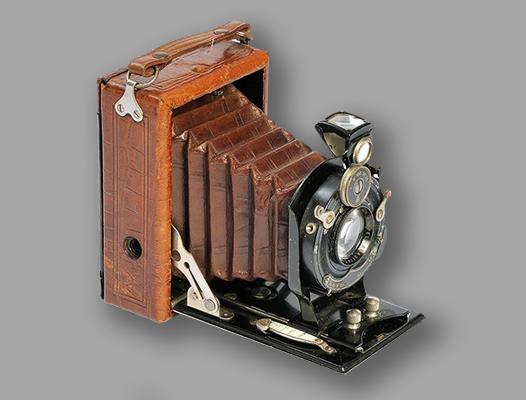
Foth folding camera 6.5 x 9, The luxury finish; The camera was available with standard black leatherette and, as the luxus edition, with brown leather imitating crocodile skin(1930–32)
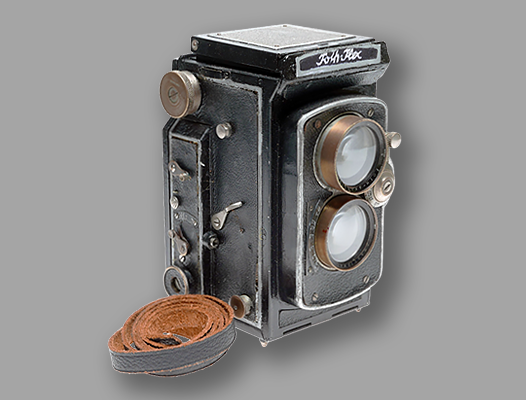
The Foth-Flex is a TLR camera for 6×6 cm exposures on 120 film, produced by Foth in Germany in 1935. It has a number of unusual features for a TLR. It is one of the very few TLR to use a focal plane shutter; the 1936 Mentorett is another one.
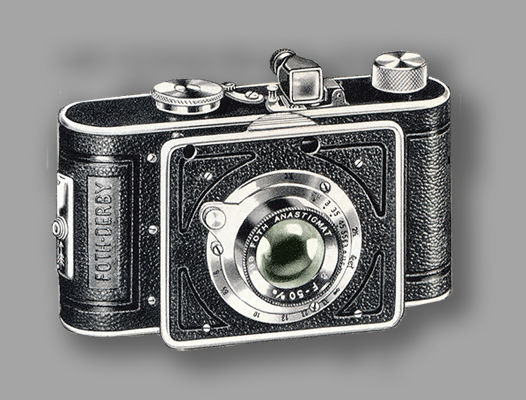
Illustration of a Foth Derby Super Speed camera. It was manufactured circa 1935 to 1939. This is considered to be the third version of the Derby evolution. Although advertised as “Super Speed” The focal plane shutter provided the same speeds as earlier versions, from 1/25 to 1/100th of a second.
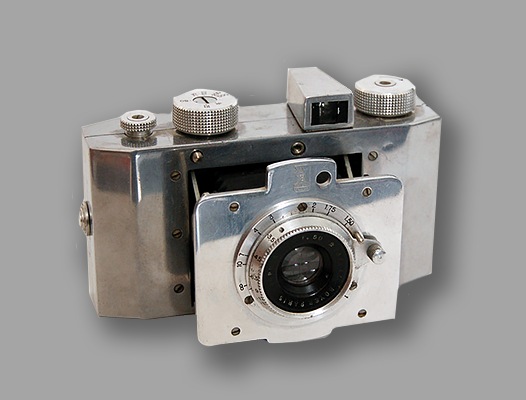
Gallus Derby-Lux, French replica of the Foth Derby with aluminum body (circa 1945). In 1947, the Derby-Lux would be renamed the Derlux and would remain in production until the early 1950s.
COMPANY NAMES:
Fototecnica Torino;
The company ceased the activities on 27 January 1956.
COMPANY ADDRESSES:
1946: Via Urbino 33, Turin.
Fototecnica Torino made several rather stylish box cameras through the 1950s. The full line of cameras became known for their balance between good quality and economical price.
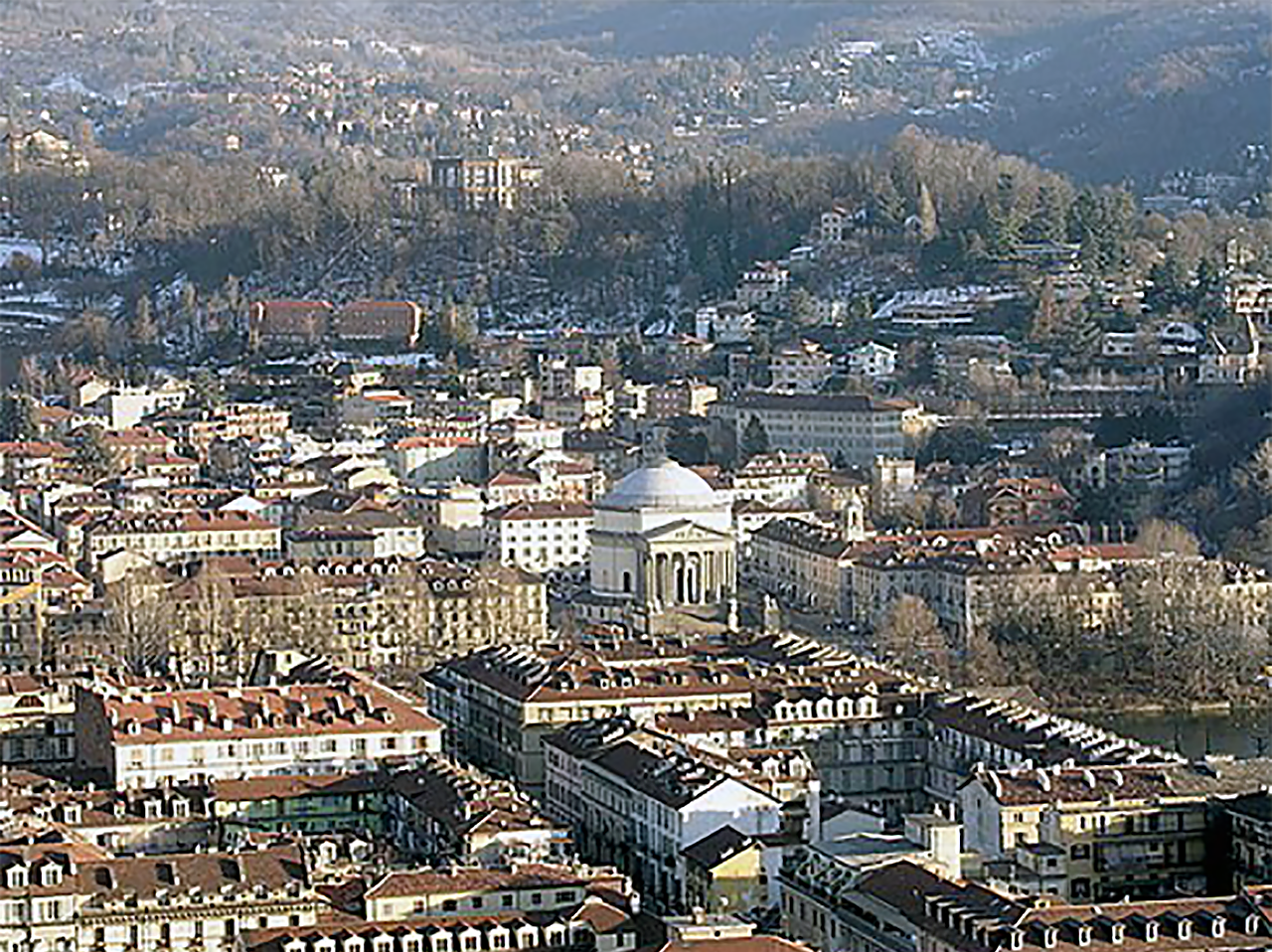
Bird’s eye view of the city of Turin
- Bandi (1946) 6 x 6 cm
- Rayflex (1946) 6 x 6 cm camera with large brilliant finder
- Filmor (1950) 6 x 6 or 6 x 9
- Eaglet (1952) 6 x 9 cm
- Maxima
- Rayelle (1954) 6 x 9 cm
- Bakina (1946) 3 x 4 cm on 127 film
- Herman (1950) 35 mm viewfinder camera
- Herman Olympic type
- Herman Olympic Gold
- Tennar (1954) 6 x 9 folding camera
- Tennar 620
In circa 1946, after the second world war, the company Fototecnica was founded in the Italian car-industry capital Turin to produce photographic equipment. The first camera offered were simple box cameras.
In 1948, on the occasion of the 26th Fiera di Milano, Fototecnica introduced the Herman, an eye-level 35 mm viewfinder camera. The camera provided 24 x 36 mm frames on common 35 mm film. The first version of the Herman was equipped with a Tecnar 3.5/50 mm lens made by Koristka. The shutter, produced by the same company, has shutter speeds ranging from 1/25 to 1/200 of a second.
In 1948 too, Fototecnica launched the Bandi, a 6 x 9 box camera, for a popular price. This box camera has an anodized aluminium front, shutter speeds from 1/25 to 1/125 and is equipped with a device preventing double exposures. But the most curious feature of this box is that the leather camera bag becomes part of the body of the camera since it is integrated with the metal back part.
To get an idea of the prices, keep in mind that in 1948/49 the Bandi cost 4,500 Lire. In 1949 the exchange rate for the Lire was 1 dollar = 625 Lire. This means that the price was $ 7.20 for the Bandi at the time. Converted, a dollar of 1949 would now be worth $ 10.98. This means that the Bandi would now have a price of $ 79.
From the early 1950s the Fototecnica launched the Tennar. This was a 6 x 9 folding camera for 120 roll film, made in different versions. The standard (basic) model had only two shutter speeds (I and B), the Tennar Lusso had more speeds available, and the Tennar Super was also equipped with a rangefinder.
Some Tennar cameras have a P&B logo on the shutter, a manufacturer who worked in Turin in the years around the Second World War on behalf of a well-known company that distributed photographic articles to wholesalers. (Ro-To or Ropolo).
In the years around 1953 three box type cameras appeared: the Eaglet both in the 4.5 x 6 and 6 x 6 format, the Filmor in the 6 x 9 format and the Rayflex in the 6 x 6 format, all of course suitable for 120 roll film. In the same period, a 127-film camera is also introduced, the Bakina for 3 x 4 cm.
Last but not least to mention is the Herman Olympic; a very special camera which was introduced in 1955. This was a further development of the original Herman camera supplemented with various novelties, such as the presence of the rangefinder and the availability of various aperture settings and shutter settings.
Of this Herman Olympic, which bears the five multi-coloured circles of the Olympic logo on the front, are two limited series produced. The first series was made of brass and covered in green leather (showed on the Milan fair of 1955), the second series consists of just ten numbered cameras, manufactured in 18 carat gold, and dedicated to personalities of those days.
The production of Fototecnica ceased at the late fifties with a model, the Microlux for 24 x 36 mm frames, which never got beyond the design stage.
FOUNDERS: Franz and Leoni Vyskocil
COMPANY NAMES:
1909: Manufacture of Photographic Equipment , Stuttgart; 1909: Vysko-Fabrik Franz Vyskocil-, Bayreuth; 1910: Weigand & Vyskocil; 1912: Frankonia-Kamerawerk; 1914: Hogaschwerk; 1914/1915: Franka-Kamerawerk; In 1962 Franka was sold to Henry Wirgin (Wirgin) and camera production ceased in 1967.
COMPANY ADDRESSES:
1909: Stuttgart; 1909: Inselstrasse 17, Bayreuth district of Sankt Georgen; 1920: Jahnstrasse 8/10, Bayreuth.
The Franka Kamerawerk was a manufacturer of camera equipment situated in Bayreuth, Germany. In its time the biggest camera factory in the Bavarian region of Oberfranken (Upper Frankonia). It existed between 1910 and 1967 and built inexpensive cameras. The most distinctive cameras of Franka are the 16mm cameras with built-in meter which were developed together with Wirgin, and the twin-format cameras with two viewfinders.
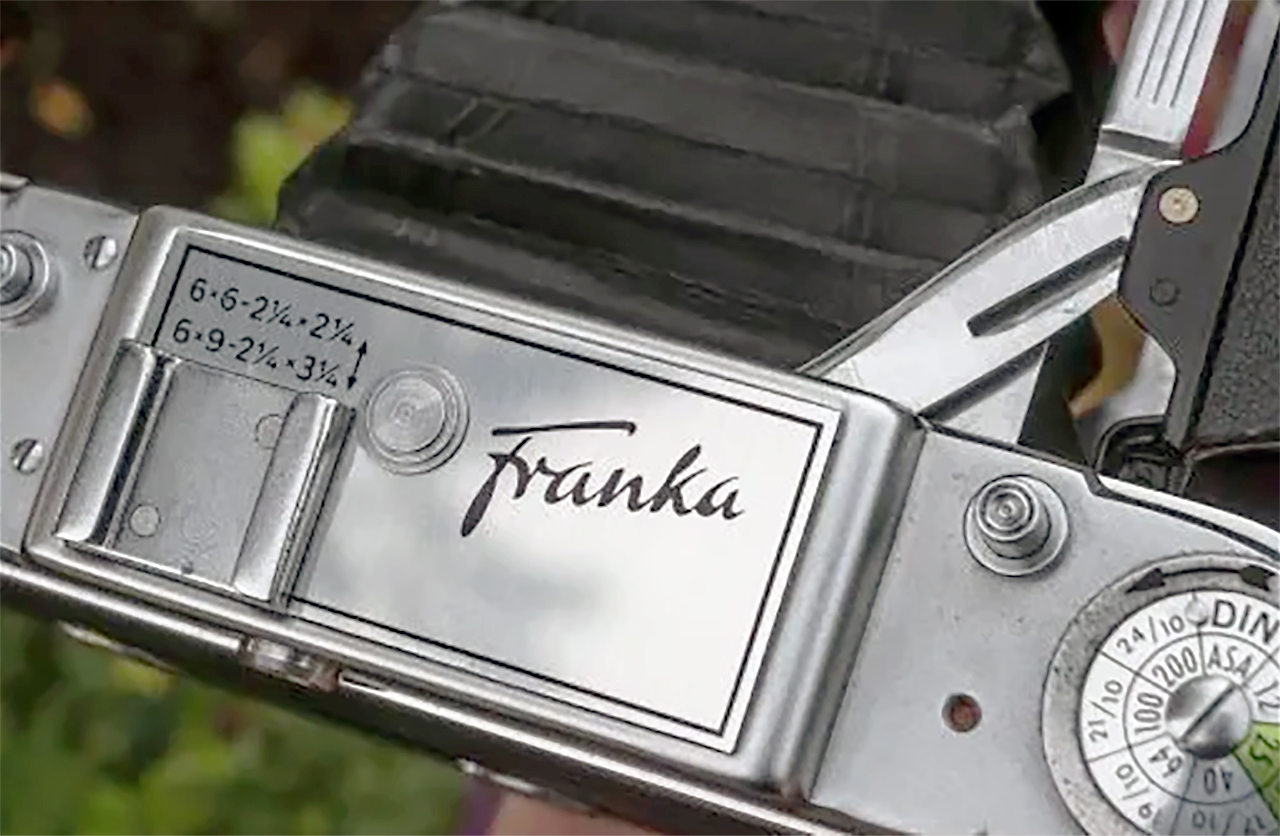
The picture shows the building of the former Franka camera factory in Bayreuth, Jahnstrasse 8/10. The sign, to the right of the entrance door, was donated in June 2006 by the Franconian Union, Bayreuth group.
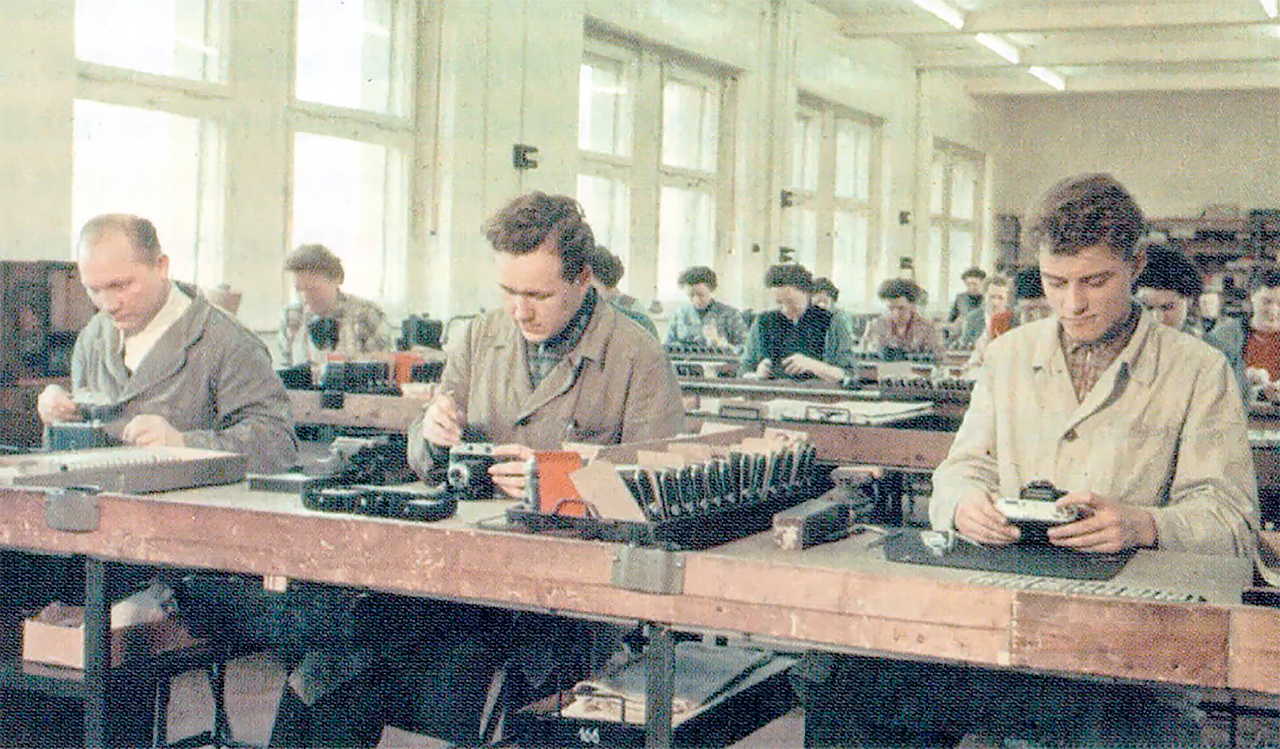
Franka Solida II cameras being assembled in the Franka-Werk factory in Bayreuth, Germany 1958
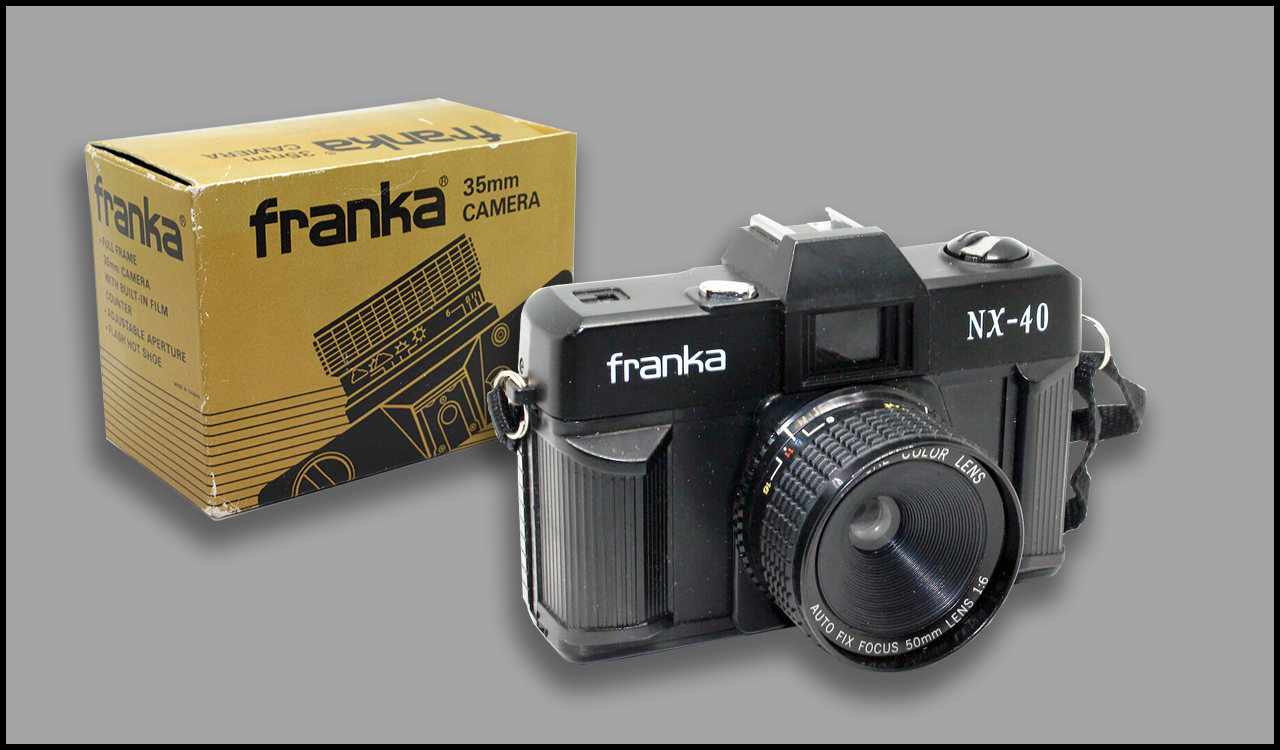
Vintage Franka NX-40 from the 1980s. This plastic lightweight compact ‘toy’ camera for 35mm film features a 50mm 1:6 fixed focus lens.
 The company was founded in Stuttgart in 1909 by Franz Vyskocil and his wife Leoni Vyskocil. There they had a small factory and shop for cameras and photographic supply under the name of Manufacture of Photographic Equipment.
The company was founded in Stuttgart in 1909 by Franz Vyskocil and his wife Leoni Vyskocil. There they had a small factory and shop for cameras and photographic supply under the name of Manufacture of Photographic Equipment.
In the same year they moved to Bayreuth, where they reopened their business as Vysko-Fabrik Franz Vyskocil, in the Inselstrasse 17 in the Bayreuth district of Sankt Georgen. That was the address that later temporarily housed the Steiner-Optik company.
In newspapers they announced their new mass fabrication of folding cameras. In 1910 their sponsor Weigand from Berneck entered the company, then named Weigand & Vyskocil. In 1912 the company was refounded as Frankonia-Kamerawerk. In 1913 the company was refounded with Weigand as its sole owner and camera salesman A. W. Schulze from Dresden as partner. In 1914 the company was named Hogaschwerk. Five months later it got its final name, Franka-Kamerawerk.
Until 1915 the company had been successfully producing plate cameras, among them one for a small format. In WWI this camera had been sold with slogans like “Mit Franka in den Krieg” (with Franka to war). The era of the Franka plate cameras lasted until 1930. The earliest cameras by Franka were made of metal. Two thirds of the camera production was made for export.
Starting difficulties
Despite conspicuous advertising, Franka suffered from starting difficulties and had to dissolve several times in the first few years. The turning point came when the accountant Wolfgang Hirschmann joined the company in July 1915. The company was now officially named “Franka-Kamerawerk. According to an announcement by the local district court in 1918, Hirschmann “is operating a manufacturing and trading business for metal and wood products, in particular photographic apparatus and supplies, since October 1, 1917“.
In 1917 Hirschmann replaced A. W. Schulze in the management. During the war and in the early 1920s the company had some non-photographic products in its portfolio. In 1919 the company moved to the city center of Bayreuth, to the location of the former Merkel Vinegar and Liqueur factory in the Jahnstrasse 8/10, and according to the information board attached to the building, the company had been located here since 1920, and there the company stayed. The stately Jahnstrasse 8/10 building, which was increased twice, had to be heightened in 1955.
Production and number of employees rose strongly in the following four years. At first the upward trend at the new location was slow. In the early 1920s, the company was gradually converted to the exclusive production of cameras. At first, plate cameras and roll film apparatus were created, later small-format cameras were added.
The decade before and after Worldwar II
In 1930 the roll film era finally reached Franka. Many Franka roll film cameras were delivered with a separate frame which could be used optionally in the camera for shooting a smaller exposure format. In 1939 Franka constructed its first 35mm camera, the Kleinbildkamera, but began its production slowly after the war.
In 1941 Hirschmann’s brother Hans and the long-term employee Georg Zettner became the managers. The Steiner company, founded in 1947, soon supplied high-quality non-composite lenses and complete lenses.
The stately Jahnstrasse 8/10 building, which was increased twice and was heightened in 1955, witnesses a good order situation and large production in these years. Around two thirds of the devices were exported all over the world.
In 1958 the number of employees had risen to 154 and production of 650,000 cameras, and owner was now Wolfgang Hirschmann’s brother Hans. In 1959 Hans and Wolfgang Hirschmann together were owners of the company.
Losing market and independence
The Franka-Kamerawerk made cameras for camera traders like Wenz and Klingel, warehouses like Kaufhof and Sears or camera distributors like Birnbaum and Porst and from 1961 for its transferee Wirgin. Even Burke & James sold cameras of Franka (until 1941).
In the mid-1960s the factory took over a part of the production of Agfa’s cameras Silette, Rapid, Isoflash Rapid and Iso-Rapid I. The perfect proof for Franka’s renownedness is the fake “Franka NX-40”, a toy camera which was also sold badged otherwise.
From the end of the 1950s, the pressure of the Japanese competition on the world market increased, which particularly affected the export-oriented Franka plant. In November 1962, Henry Wirgin from Wiesbaden bought the company and managed it from there. However, he could not stop the decline. Hans Hirschmann and Georg Zettner lost procurement but stayed in the company.
Highlights of the last years of Franka were the cameras for 13×16mm exposure format, sold as Franka 16 and Edixa 16. Production ceased in December 1966 and finally ended in September 1967. The machines were moved to Wiesbaden where most of them weren’t used anymore. Only the production of the Edixa 16 was continued there for a short while. The city Bayreuth has ensured that the facade of the building has been renovated (status in May 2019).
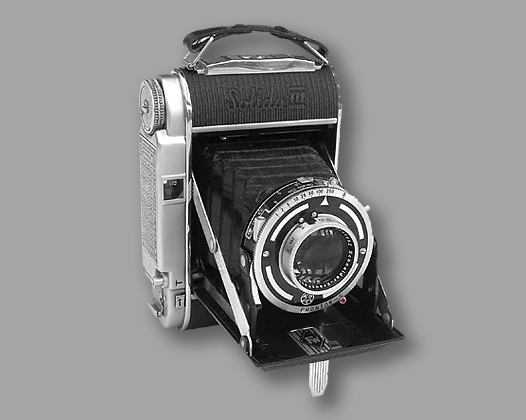
The “Franka Solida III” for the 6×6 format appeared in 1953 and cost 126 marks with the “Schneider Radionar 2.9/80 mm” and the Prontor SV shutter; with the “Rodenstock Trinar” and the Synchro-Compur 150 marks. There was also the “III E” model with an uncoupled range finder.
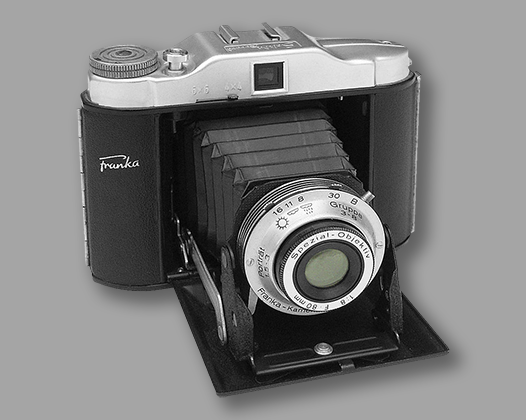
Among the innumerable variants that Franka-Werk manufactured from their successful 6×6 model “Solida”, this “Solida Record B” brought up the rear. The Franka Solida Record B came onto the market in 1958 and was sold 78,000 times in three years. The price was 33 DM. The entire “Solida” production from 1951 to 1961 amounted to almost 448,000 6×6 cameras.
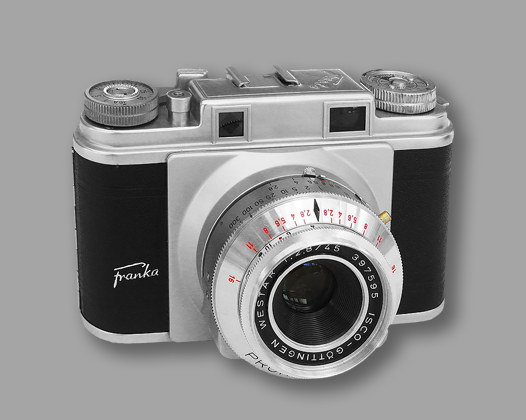
The ‘Franka E’ shown was released in 1960 and had a coupled rangefinder, Prontor SVS shutter and 45mm f/2.8 ‘Westar’.
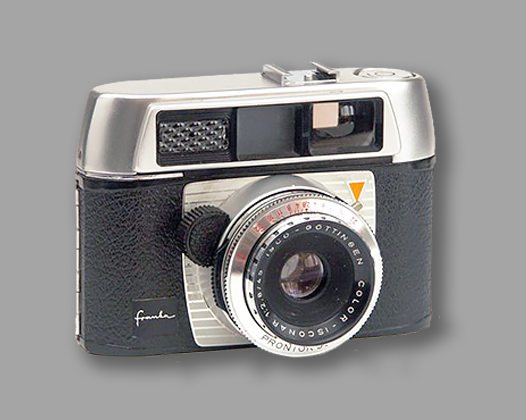
This Franka camera – without model name – is a Franka Edixa 500-LK according to the ‘Kadlubeck guide’ and was produced from 1960, the year in which the company ‘Franka’ merged with Wirgin Edixa. The Franka 500-LK is not such a special camera in itself, but it was in the early years that the pointer of the built-in and linked (selenium) light meter could be followed in the viewfinder – instead of with its competitors on top of the camera.
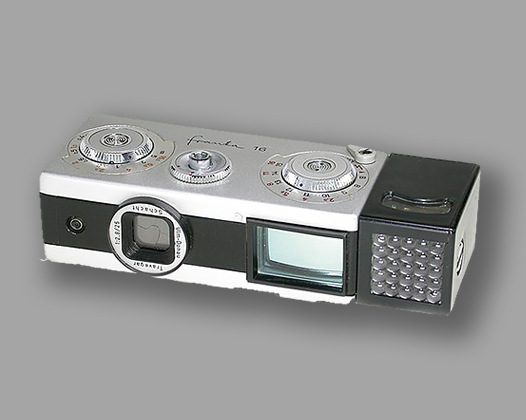
Highlights of the last years of Franka were the cameras for 13×16mm exposure format, sold as Franka 16 and Edixa 16. It is a miniature camera (format 12 x 17 mm) built in 1964. Lens Travegar 1:2.8/25 mm (“Schacht/Ulm-Donau”), quick release lever, here with the screw-on exposure meter. Corresponds to the Edixa 16 and the Alka 16 (for Karstadt).
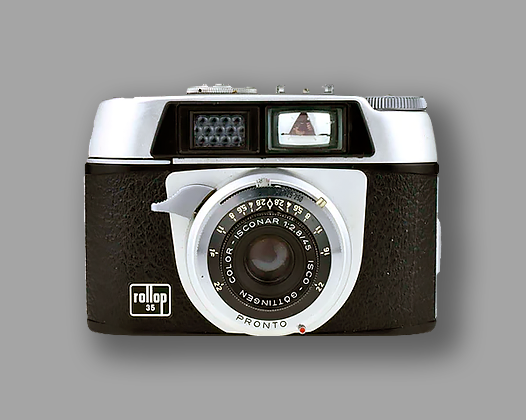
Kaufhof (Rollop)/Franka Werke – 35mm film, viewfinder camera c1965-1966. Same as Franka 125.The Franka-Kamerawerk made cameras for camera traders like Wenz and Klingel, warehouses like Kaufhof and Sears or camera distributors like Birnbaum and Porst and from 1961 for its transferee Wirgin.
Products
The first product was a plate camera in the then usual format 9 × 12 cm, followed by cameras for smaller formats. In 1916, eleven models were offered in different price and design variants. The First World War temporarily brought production to a standstill. Around 1930, the factory mainly produced 6 × 9 roll film cameras.
Cooperation with Photo Porst began in the 1930s. The best seller was the Franka-Bubi for the 4 × 6½ cm roll film format. Shortly before the Second World War, Franka-Werke launched 35mm cameras. However, these devices were only produced in small numbers and found hardly any buyers.
After 1945 mainly 6 × 9 cm (up to 1957) and 6 × 6 cm (until 1965) roll film cameras were built. The Solida-1, a medium-format folding camera with bellows, which was produced from 1951, was widely used.
From around 1954 the production of 35mm cameras began, which were considered “small miracles of precision engineering” with a “long service life”. At that time, a 35 mm viewfinder camera with interchangeable lenses was also developed. It was the time when roll film camera production switched from 6×9 to 6×6 format cameras.
The Super Frankarette from 1959, with a Xenar lens, coupled rangefinder and built-in light meter, was popular. The Edixa-16 miniature camera was created in the 1960s.
Final developments
Franka’s last own camera development was very successful, the Frankamatic Lux, with a selenium meter coupled to shutter, aperture and an underexposure indicator in the viewfinder.
Highlights of the last years of Franka were the cameras for 13×16mm exposure format, sold as Franka 16 and Edixa 16. The Franka 16 subminiature using 16mm film was conceived by Wirgin. Its further development and production was given to the Franka-Kamerawerk. In 1966 the factory’s production was stopped.
Between 1951 and 1961, 326,000 6 x 6 cm cameras were built. In the years 1953 to 1957 approx. 88,000 cameras in 6 × 9 cm format left the factory, from 1957 to 1961 a total of 96,000 35mm cameras were produced. According to an advertising brochure, production had increased tenfold between 1938 and 1956.
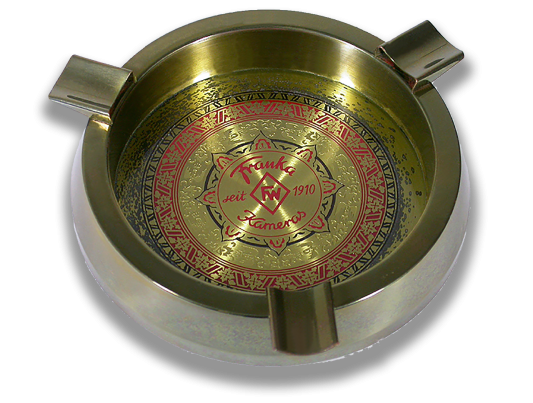
A promotional gift from the time when smoking was still very common: an ashtray complete with Franka logo.
The Franka camera production range included:
- Franka 500 LK
- Franka (Edixa)
- Franka Francolor (1960)
- Franka Francolor (1962)
- Franka Franka-matic
- Franka Frankarette (kleiner Sucher)
- Franka Frankarette (großer Sucher)
- Franka Frankarette II (1959)
- Franka Super Frankarette
- Franka Super-Frankarette SLK
- Franka 16: The Mini-Edixa from Bayreuth
- Franka Plate Camera 9 x 12 cm
- Franka Bonafix: 6 x 9/6 x 6-Apparat in four executions
- Franka Solida: folding camera from Bayreuth
- Franka Solida I
- Franka Solida III: Fast 6 x 6-folding camera
- Franka Solida “FW”: Lens 1:3,5/75 mm
- Franka Solida “FW” black top: Lens 1:3,5/75 mm
- Franka Solida jr.: Two-format camera for roll film (switchable viewfinder)
- Franka Solida Record: 6 x 6-Kamera with fold-out bellows
- Franka Solida Record: Two-format camera with bellows and transport wheel
- Franka Solida Record: Two-format camera with transport wheel
- Franka Solida-Record TS: Roll film camera 6 x 6 cm with quick shift lever
- Franka Solida-Record B: Two-format camera with bellows (2 viewers)
- Franka Solida-Rekord T: simpel two-format camera (2 viewers)
- Alka 16 (for Karstadt – identical in construction to Franka 16)
- Edixa 16 U (identical in construction to Franka 16)
- OGA Kleinbild (similar to this Franka)
- OGA Rollfilm (identical in construction to Solida-Record)
- Rollop 35
COMPANY NAMES:
1934: Fuji Photo Film Co., Ltd.; 1944: Fuji Photo Optical Co., Ltd.;
COMPANY ADDRESSES:
1934: Minami-Ashigara , now a city in the prefecture of Kanagawa, Japan;
Fujifilm Corporation is a Japanese company, which originally appeared as a film manufacturer and later expanded as a camera maker. Before 2006, the corporate name was Fuji Photo Film Co., Ltd. and many photographers continue to use the name “Fuji” informally.
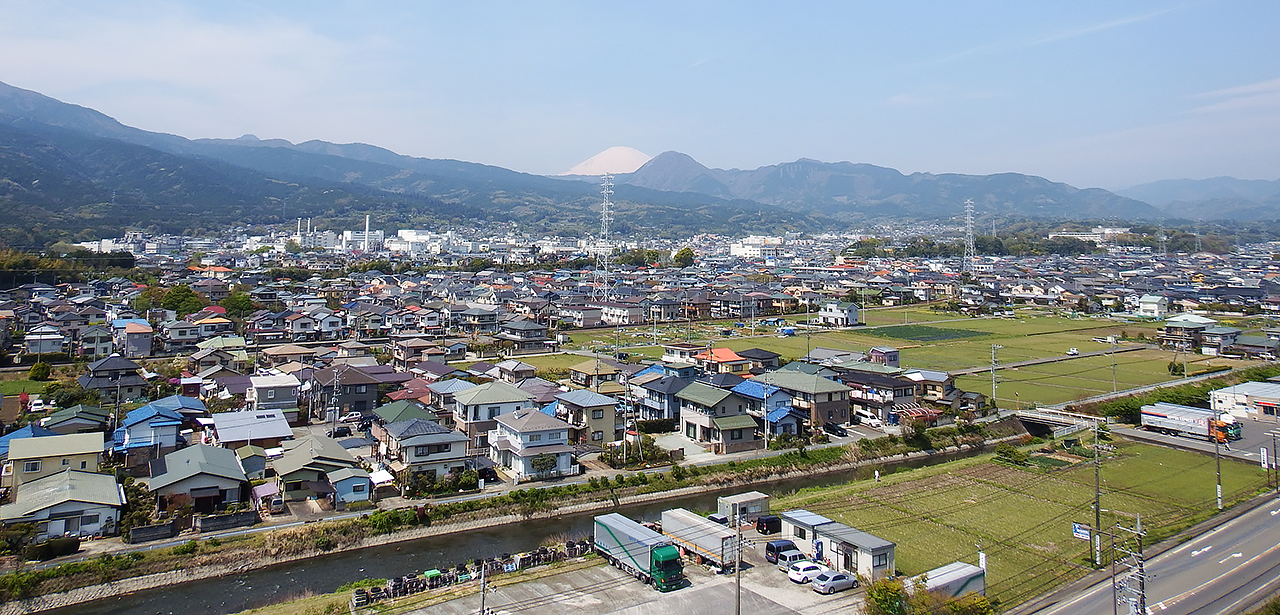
Skyline of Minamiashigara City, a city in the prefecture of Kanagawa, at the foot of Mount Hakone
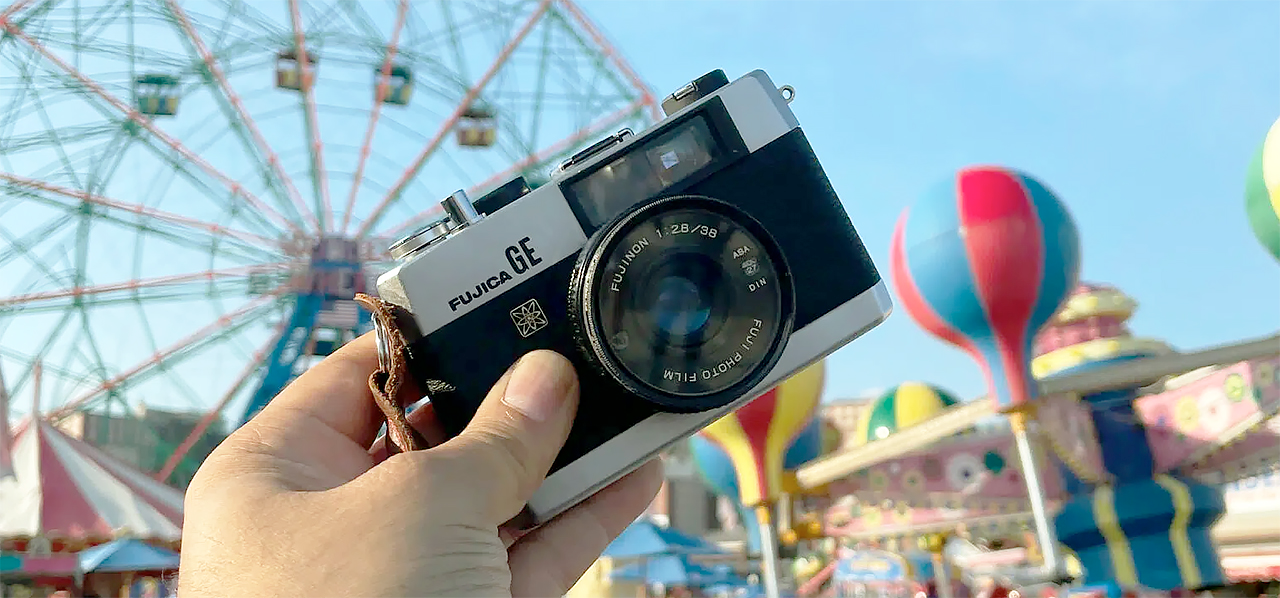
The 35mm Fujica GE camera, launched in the 1970s, is known for its sturdy design, simplicity, and exceptional photographic results. The Fujica GE body is constructed with a combination of sturdy metal and plastic, making it a durable camera. Its ergonomic shape and intuitive controls make handling easy.
The company was founded on January 20, 1934 as Fuji Shashin Film K.K., later translated as Fuji Photo Film Co., Ltd., producing several sorts of film. It was an offshoot of Dai-Nippon Celluloid K.K., founded in 1919. The company’s first CEO was Asano Shūichi. The plants were located in the village of Minami-Ashigara, now a city in the prefecture of Kanagawa, at the foot of Mount Hakone. It is said that the name “Fuji” was chosen by Asano Shūichi because of Mount Fuji, situated not far from Mount Hakone, but was already registered by a third party, to which the rights were bought for 8,000 yen, an important sum at the time.
The company started to produce optical glass during the early 1940s for military use. The dependent company Fuji Shashin Kōki K.K., meaning “Fuji Photo Optical Co., Ltd.” was founded in 1944, from the assets of Enomoto Kōgaku Seiki Seisakusho. Fuji Photo Optical Company, Ltd. became known as Fujinon, one of about thirty five consolidated subsidiaries (Domestic Group Companies) of Fuji Photo Film Co., Ltd. based in Tokyo, Japan – with even more located overseas!
Camera production
Fuji began producing cameras in 1948 with the Fujica Six. Until the late 1970s, many cameras made by Fuji were called Fujica, a contraction of Fuji and camera (cf Leica, Yashica etc.). In the mid 1980’s the Fujica name change to simply Fuji, in the mid 1990’s this changed yet again to Fujifilm.
The company started producing digital cameras in 1988. Fujifilm was the most agile among film makers in adapting to digital imaging. For a while it offered leading technology concerning smaller digital consumer cameras with high-sensitivity CCDs.
It also sold expensive DSLRs and innovative camera concepts like the X100 with hybrid finder, a mixture of optical finder and EVF. Nowadays it is one of the big makers of sophisticated CSCs like the X-T3 with fast hi-res video capability.
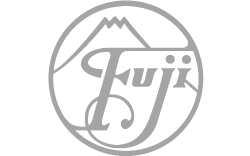
Here is a list of Fujica branded still photo cameras that were produced and their date of introduction.
Single-8 Film cameras are not listed.
- Fujica ST-F (1975)
- Fujicarex (1962)
- Fujicarex II (1963)
- Fuji Half SLR design concept
M42 mount
- Fujica AZ-1 (1978)
- Fujica ST601 (1975)
- Fujica ST605 (1976)
- Fujica ST605N (1978)
- Fujica ST605 II (1978)
- Fujica ST701 (1970)
- Fujica ST705 (1976)
- Fujica ST705W (1978)
- Fujica ST801 (1972)
- Fujica ST901 (1974)
Fujica X mount
- Fuji AX Multi Program
- Fujica AX-1 (1980)
- Fujica AX-3 (1980)
- Fujica AX-5 (1980)
- Fujica MPF105X (1979)
- Fujica MPF105XN (1983)
- Fujica STX-1 (1979)
- Fujica STX-1N (1983)
- Fuji STX-2 (1985)
Rangefinder cameras
No exposure meter
- Fujica 35-M
- Fujica 35-ML
- Fujica SP
Exposure meter but no auto exposure
- Fujica 35SE
- Fujica 35ML F2.8
Auto exposure
- Fujica 35-EE
- Fujica 35 Auto M (1962)
- Fujica V2
- Fujica Compact D (1969)
- Fujica Compact S (1969)
- Fujica Light Compact S (1970)
- Fujica Compact Deluxe (1970)
- Fujica GER
cameras
These two cameras did not go past the mock-up stage:
- Fujica 16mm SLR
- Fujica 8×11mm SLR
cameras
- Fuji Disc 50
- Fuji Disc 70
single use cameras
- Fujifilm QuickSnap
- Fujifilm QuickSnap Colors APS camera
- Fujifilm QuickSnap Fashion 400
- Fujifilm QuickSnap Flash
- Fujifilm QuickSnap Flash 1000
- Fujifilm QuickSnap Flash 400
- Fujifilm QuickSnap Golf – sequence camera, 800 ISO
- Fujifilm QuickSnap Outdoor 1000
- Fujifilm QuickSnap SmartFlash
- Fujifilm Smart QuickSnap Super Slim Outdoor APS camera
- Fujifilm QuickSnap Superia – 800 ISO
- Fujifilm Quicksnap Tele 100mm 800ISO
- Fujifilm QuickSnap Marine / Waterproof – waterproof, 800 ISO
- Fujifilm Quicksnap Panorama
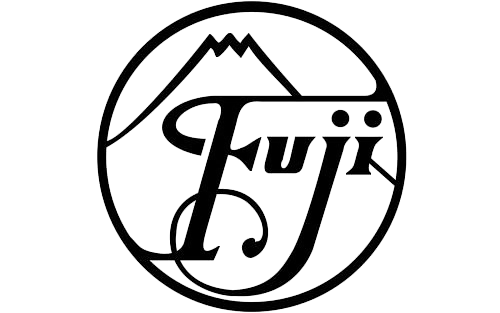
cameras
No exposure meter
- Fujica 35 (folder), prototype only
- Fujipet 35
Auto exposure
- Fujica 35 Automagic
- Fujica Compact 35 – 1967
- New Fujica Compact 35 – 1969
- Fujica Light Compact 35 – 1970
- Fujica 35 FS – 1971
- Fujica 35GP – 1972
- Fujica GE – 1973
- Fujica GA – 1975
- Fujica Date
- Flash Fujica – 1976
- Fujica Flash (Date) – 1976
- Fujica Flash II – 1978
- Fujica Flash S – 1978
- Fujica Auto-5 – 1980
- Fujica Auto-7 – 1981
- Fuji Auto-8 Date
- Fuji Auto-70 DX – 1985
- Fujica DL-20 – 1983
- Fuji PicPAL 2 – 1985
- Fuji Flash S2 – 1985
Rugged
- Fujica HD-1 – 1979
- Fuji HD-R
- Fujica HD-S – 1979
- Fuji HD-M (Tough Guy) – 1984
- Fuji HD-P Panorama – 1990
- Fuji K-35 – 1991
- Fuji K-28 – 1991
Point&Shoot cameras
Fixed focal length
- Fujifilm Clear Shot/Smart Shot series (Clear Shot M, Smart Shot Plus, V, 60AF etc.)
Fixed Focus
- Fujica M1 – 1979
- Fujica MA-1 – 1981
- Fujica MF – 1982
- Fujica PicPAL – 1982
- Fuji Mickey Mouse
- Fuji DL-10 (Friend) – 1986
- Fuji DL-7 – 1987
- Fuji Mickey Mouse DL-7 – 1987
- Fuji DL-7 Plus (Fuji DL-8) – 1990
- Fuji DL-15 – 1988
- Fuji DL-25 – 1990
- Fuji DL-25 Plus – 1993
- Fuji DL-35 – 1992
- Fuji Bene – 1989
- Fuji FZ-5 – 1989
- Fuji Hi! Mickey Mouse – 1990
- Fuji Cardia Panorama – 1991
- Fuji Rensha Cardia (eight lens camera) – 1991
- Fujifilm Rensha Cardia Byu-n 16 (sixteen lens camera) – 1995
- Fujifilm Cardia Super 28WP – 1995
Autofocus
- Fujica Flash AF (Date)
- Fujica DL-100 (Auto Ace) – 1983
- Fuji DL-30 – 1986
- Fuji DL-50 / Fuji Lucia – 1984
- Fuji DL-60 Date / Discovery 60 / DL-55 – 1989
- Fuji DL-80 / Discovery 80 / DL-75 – 1990
- Fuji DL-80N / DL-75R – 1992
- Fuji DL-90 Date / Discovery Plus Date / Promaster 90 / DL-85 – 1993
- Fuji DL-95 Super / Discovery 90 – 1993
- Fuji DL-120 / Cardia Joy Date – 1987
- Fuji DL-150 / Cardia Cute Date – 1986
- Fuji DL-200 / Cardia – 1983
- Fuji Cardia II – 1986
- Fuji DL-300 / Fuji Cardia Hite Date – 1986
- Fuji DL-510 / Fuji Cardia Mini Everyday OP – 1992
- Fuji Work Record 28 (1993-2006) – chunky weatherproof model
- Fuji Work Record OP (1993-2006)
- Fujifilm DL-100 (Discovery S100) – 2002
- Fujifilm Natura S (Natura Black F1.9)
- Fujifilm Cardia Mini Tiara / DL Super MiNi – 1994
- Fujifilm Klasse – 2001
- Fujifilm Klasse S – 2006
- Fujifilm Klasse W – 2007
zoom cameras
- Fujifilm Zoom Date 90 / Discovery Zoom 90 Date / Super 90AZ (38-90) – 2000
- Fujifilm Zoom Date 120 / Super 120AZ (38-120) – 2000
- Fujifilm Zoom Date 145 / Discovery S1450 Date / Super 145AZ (38-145) – 2001
- Fujifilm Super 1200AZ (38-120) – 2001
- Fujifilm Zoom Date 60 / Zoom 60 (38-60) – 2001
- Fujifilm Zoom Date 60EZ (38-60) – 2002
- Fujifilm Silvi 70 / Zoom Date 70 / Zoom Date 77 / Zoom 70 – 2001
- Fujifilm Zoom Date 70 / DL-270 Zoom Super (35 to 70mm) – 2003
- Fujifilm Zoom Date 140 (38-140) – 2001
- Fujifilm Zoom Date 140EZ (38-140) – 2002
- Fujifilm Zoom Date 100 (38-100) – 2002
- Fujifilm Zoom Date 115 / Zoom 115 (38-60) – 2002
- Fujifilm Zoom Date S600 / Discovery S600 Zoom Date / Discovery S600 Zoom (38-60) – 2002
- Fujifilm Discovery S700 Zoom Date / Discovery S700 Zoom / Discovery S770 Zoom (38-70) – 2003
- Fujifilm Discovery S1450 Zoom (38-145) – 2002
- Fujifilm Discovery S1200 Zoom Date / Zoom Date S1200 / Discovery S1200 Zoom (38-120) – 2002
- Fujifilm Discovery S1050 Zoom Date / Discovery S1050 Zoom (38 to 105mm) – 2002
- Fujifilm Zoom Date 1000 / Silvi 1000 (28-100) – 2001
- Fujifilm Zoom Date 1000i (28-100) – 2003
- Fujifilm Zoom Date 1300 / Silvi 1300 – 2002
- Fujifilm Zoom Date 125S / Silvi 125 (38 to 125) – 2002
- Fujifilm Zoom Date 125SR – 2002
- Fujifilm Zoom Date 125EZ – 2003
- Fujifilm Zoom Date 90S / Fujifilm Zoom 90S / Silvi 90 (38-90) – 2002
- Fujifilm Zoom Date 90SR (38-90) – 2002
- Fujifilm Zoom Date 90EZ (38-90) – 2003
- Fujifilm Zoom Date F2.8 / Silvi F2.8 (24-50) – 2002
- Fujifilm Silvi F2.8 Black
- Fujifilm Zoom Date 110EZ – 2002
- Fujifilm Zoom Date 110SR – 2002
- Fujifilm Zoom Date 160S – 2003
- Fujifilm Zoom Date 160EZ – 2002
- Fujifilm Zoom Date 76S (38-76) – 2002
- Fujifilm Zoom Date 115S – 2003
- Fujifilm Zoom Date 115SR – 2002
- Fujifilm Zoom Date 60W / Zoom 60W – 2003
- Fujifilm Zoom Date 70V – 2005
- Fujifilm Zoom Date 135V / Zoom 135V / Silvi F135 – 2004
- Fujifilm Zoom Date 120V / Zoom 120V – 2004
- Fujifilm Zoom Date 90V / Zoom 90V – 2005
- Fujifilm Silvi 1600 ( 38 to 160mm) – 2001
- Fujifilm Silvi F120 – 2004
- Fujifilm Silvi Fi (28 to 100mm ) – 2003
- Fujifilm Tiara Zoom ( DL Super Mini Zoom / Cardia Mini Tiara Zoom )
- Fujifilm Natura Classica – 2004
- Fujifilm Natura N
- Fujifilm Natura NS – 2006
- Fujifilm C-1 Zoom ( 28-56mm ) – 2004
Rapid cassette
35mm cameras
- Fuji Dual (dual lens half frame)
- Fuji TW-3 (dual lens half frame)
- Fujica Half
- Fujica Half 1.9
- Fujica Drive
- Fujica Mini
- Fujica Rapid D1
- Fujica Rapid S
- Fujica Rapid SF
- Fujica Rapid S2 (24×24 mm on Rapid film)
cameras
- Fujifilm TX-1
- Fujifilm TX-2
Fujifilm uses multiple brandings for their IX240 APS film cameras. Fotonex is the branding used most everywhere, while Endeavor is in the USA, while Nexia and EPION are used in Japan.
Fixed focal length
- Fujifilm EPION “Safety First” / RVX
- Fujifilm Fotonex 10 (Endeavor 10 / EPION 10 / EPION Hello Kitty)
- Fujifilm Fotonex 15
- Fujifilm Fotonex 20 Auto / nexia 20 Auto / Endeavor 20 Auto
- Fujifilm Fotonex 50 (Endeavor 50 / EPION 50AF / EPION AF My Melody)
- Fujifilm Fotonex 55AF
- Fujifilm Fotonex 60AF (Endeavor 60AF / nexia 60AF)
- Fujifilm Fotonex 100ix (Endeavor 100ix / EPION 100)
- Fujifilm Fotonex 101ix (Endeavor 101ix / EPION 101)
- Fujifilm nexia 30
- Fujifilm nexia 31 Auto
- Fujifilm nexia 70 AF
- Fujifilm nexia Q1
Zoom
- Fujifilm nexia Q1 Zoom
- Fujifilm EPION 200Z
- Fujifilm Fotonex 200ix Zoom
- Fujifilm Endeavor 210ix (EPION 210Z)
- Fujifilm nexia 220ixZ
- Fujifilm nexia 230ixZ
- Fujifilm EPION 250Z
- Fujifilm EPION 255Z
- Fujifilm Fotonex 265ix Zoom (Fujifilm nexia 265ix Zoom / EPION 265Z)
- Fujifilm Fotonex 275ix Zoom
- Fujifilm Fotonex 300 Zoom (Endeavor 300 Zoom / Epion 300Z)
- Fujifilm EPION 305Z
- Fujifilm nexia 320ix Zoom
- Fujifilm nexia 330ix Zoom
- Fujifilm Fotonex 4000ix SL (Endeavor 4000SL / EPION 4000) – SLR
(Mid-Roll-Change)
Fixed focal length
- Fujifilm Fotonex 1000ix MRC Tiara (Endeavor 1000ix MRC Tiara / EPION 1000 MRC Tiara Titanium)
- Fujifilm Fotonex Tiara ix 1010 MRC (Endeavor Tiara ix 1010 MRC / EPION Tiara ix 1010 MRC)
Zoom
- Fujifilm nexia 250ixZ MRC
- Fujifilm Endeavor 260ix Zoom MRC / EPION 260Z MRC
- Fujifilm EPION 270Z MRC
- Fujifilm nexia 270ix Zoom MRC
- Fujifilm Endeavor 260ix Zoom MRC / EPION 310Z MRC
- Fujifilm Fotonex 400ix Zoom MRC (Endeavor 400ix Zoom MRC / EPION 400Z MRC)
- Fujifilm Fotonex 3000ix Zoom MRC / EPION 3000 MRC
- Fujifilm nexia 3100ixZ MRC
- Fujifilm Fotonex 3500ix Zoom (Endeavor 3500ix Zoom / EPION “Cardman” 3500 MRC)
- Fujifilm nexia 4100ix Z MRC
- Fujifilm nexia 2000ixZ MRC Tiara / Fujifilm nexia 2000ixZ
Pocket cameras
- Pocket Fujica 200
- Pocket Fujica 300
- Pocket Fujica 400
- Pocket Fujica 500
- Pocket Fujica 600
- Pocket Fujica 250
- Pocket Fujica 250 Flash
- Pocket Fujica 250 Tele Flash
- Pocket Fujica 330 Zoom
- Pocket Fujica 350 Wide
- Pocket Fujica 350 Flash
- Pocket Fujica 380 Flash
- Pocket Fujica 450 Flash
- Pocket Fujica 350 Zoom
- Pocket Fujica 550 Auto
- Pocket Fujica Flash AW
- Pocket Fujica Auto Pop
- Pocket Fujica Flash Zoom
- Pocket Fujica Macro Zoom
- Pocket Fujica Hello Kitty
- Pocket Fujica Micky Mouse
cameras
- Fujicaflex (TLR)
- Fujica Six (6×6 folding)
- Super Fujica Six
- Fujipet
- Fujipet EE
Rangefinder cameras
Interchangeable Lens
- Fujica G690
- Fujica G690BL
- Fujica GL690 Professional
- Fujica GM670 Professional
Fixed Lens
- Fujica GW690 Professional
- Fujica GSW690 Professional
- Fuji GW690II Professional
- Fuji GW670II Professional
- Fuji GSW690II Professional
- Fuji GW690III Professional
- Fuji GW680III Professional
- Fuji GW670III Professional
- Fuji GSW690III Professional
- Fuji GSW680III Professional
System Cameras
- Fujifilm GX645AF Professional – (2003)
- Fuji GX680 Professional – (1989)
- Fujifilm GX680II Professional – (1995)
- Fujifilm GX680S Professional – (1995)
- Fujifilm GX680III Professional – (1997)
- Fujifilm GX680IIIS Professional – (1997)
645-cameras
Manual Focus
- Fujica GS645 Professional (rangefinder)
- Fujica GS645W Wide Professional (viewfinder)
- Fuji GS645S Wide60 Professional (rangefinder)
Autofocus
- Fujifilm GA645
- Fujifilm GA645i Professional
- Fujifilm GA645W Professional
- Fujifilm GA645Wi Professional
- Fujifilm GA645Zi Professional (zoom lens)
Panorama
- Fujica Panorama G617 Professional – 1983
- Fuji Panorama G617 Professional – 1985
- Fuji Panorama GX617 Professional – 1993
GF Cameras
- Fujifilm GF670
- Fujifilm GF670W
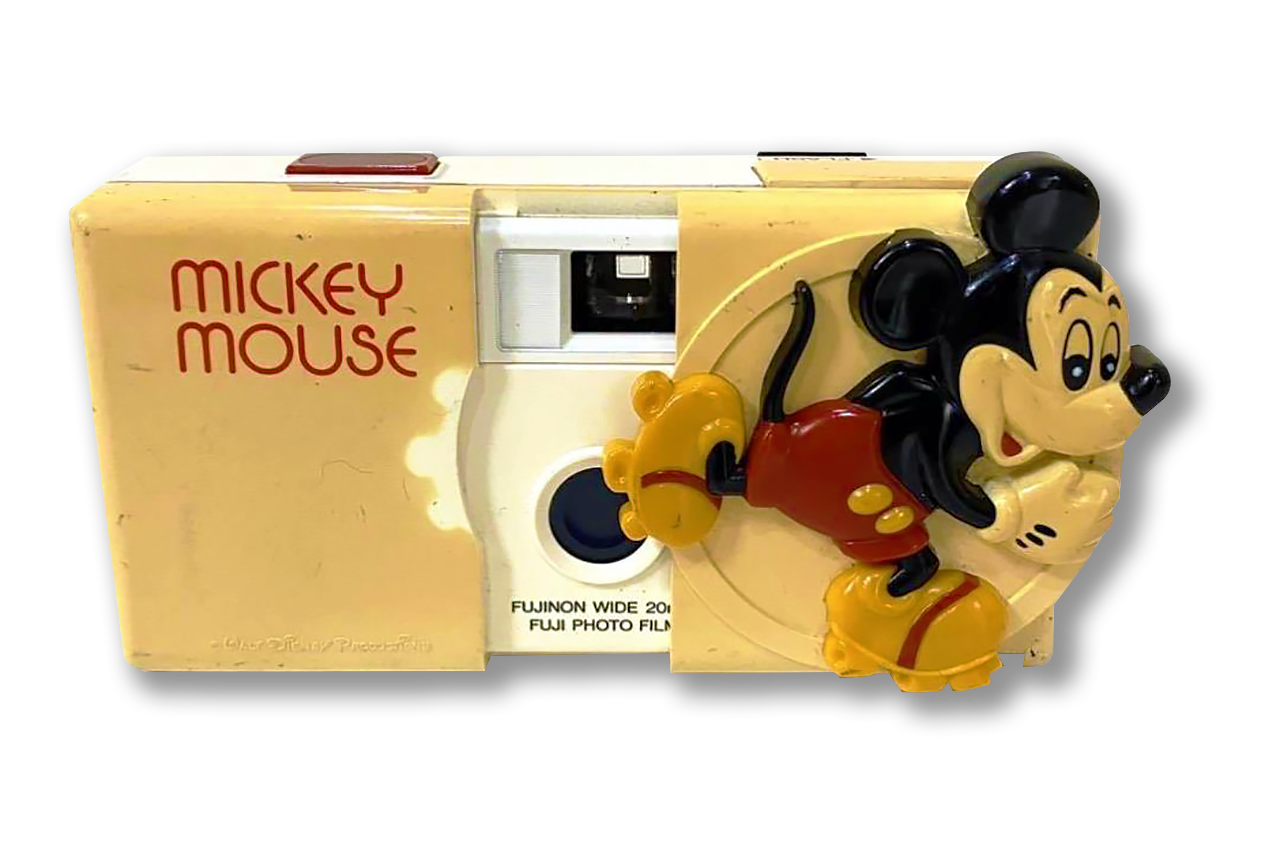
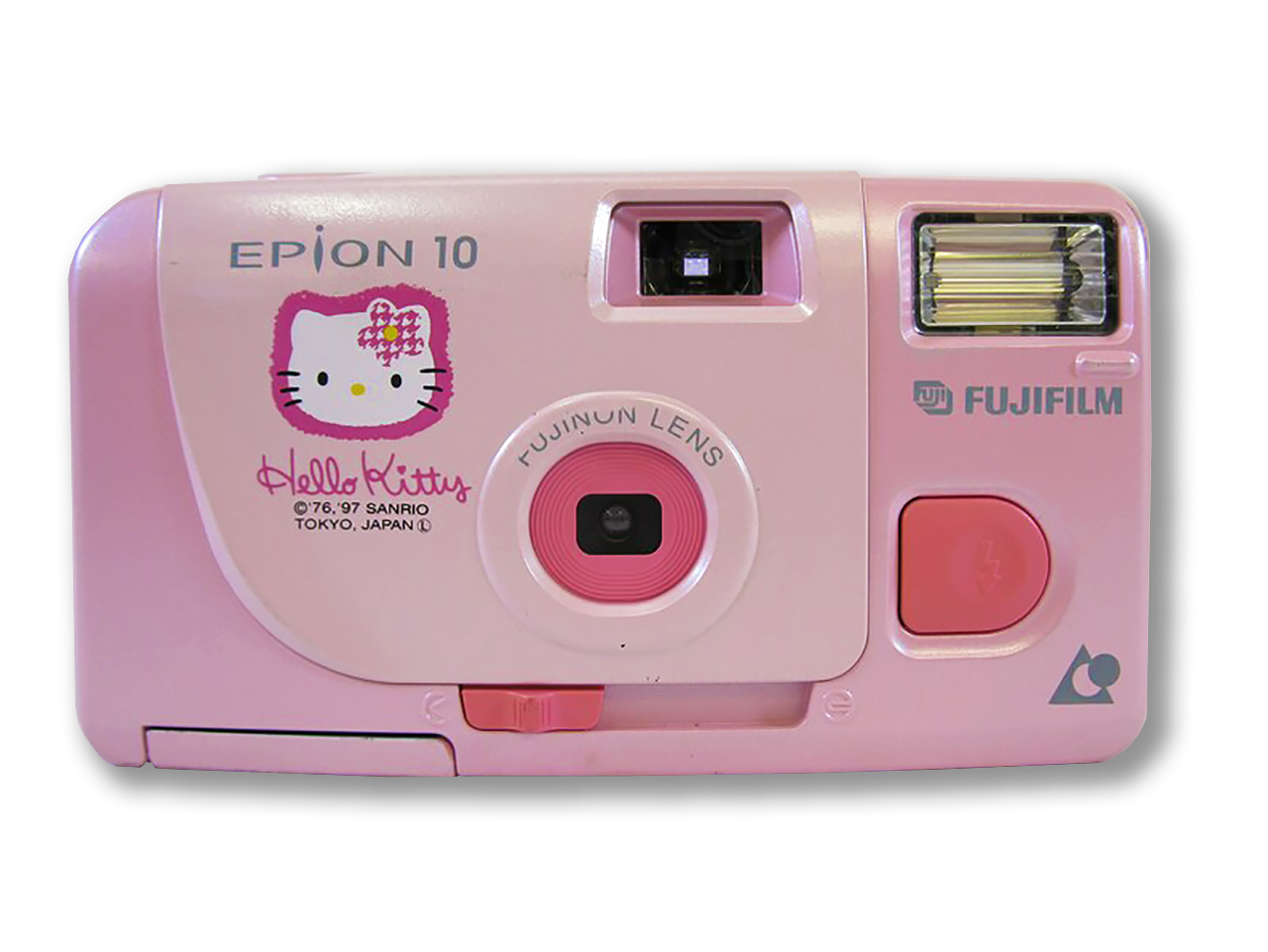
Two 110 film pocket cameras; the Pocket Fujica Micky Mouse and the Pocket Fujica Hello Kitty respectively.
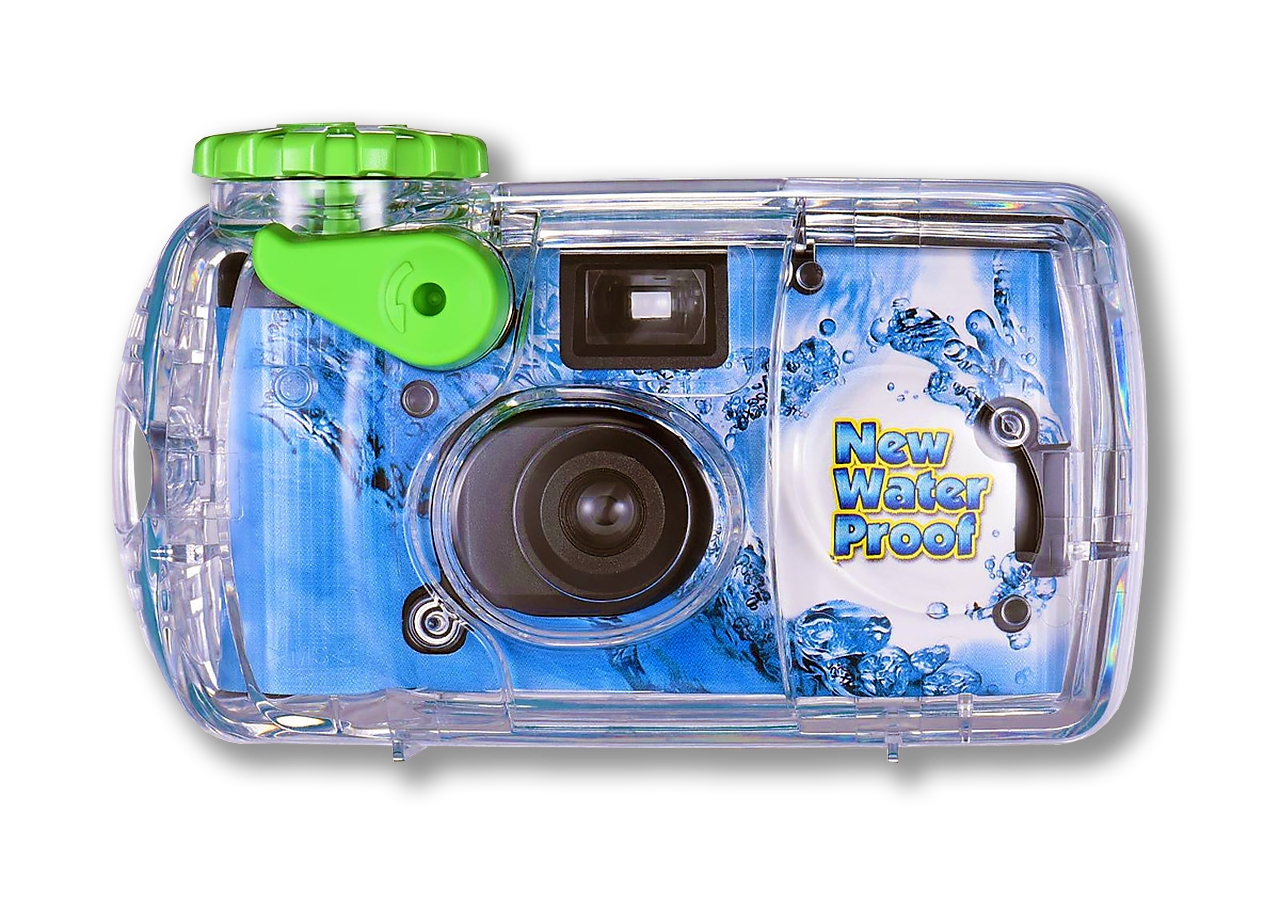
The Fujifilm single use QuickSnap Marine / Waterproof Camera.
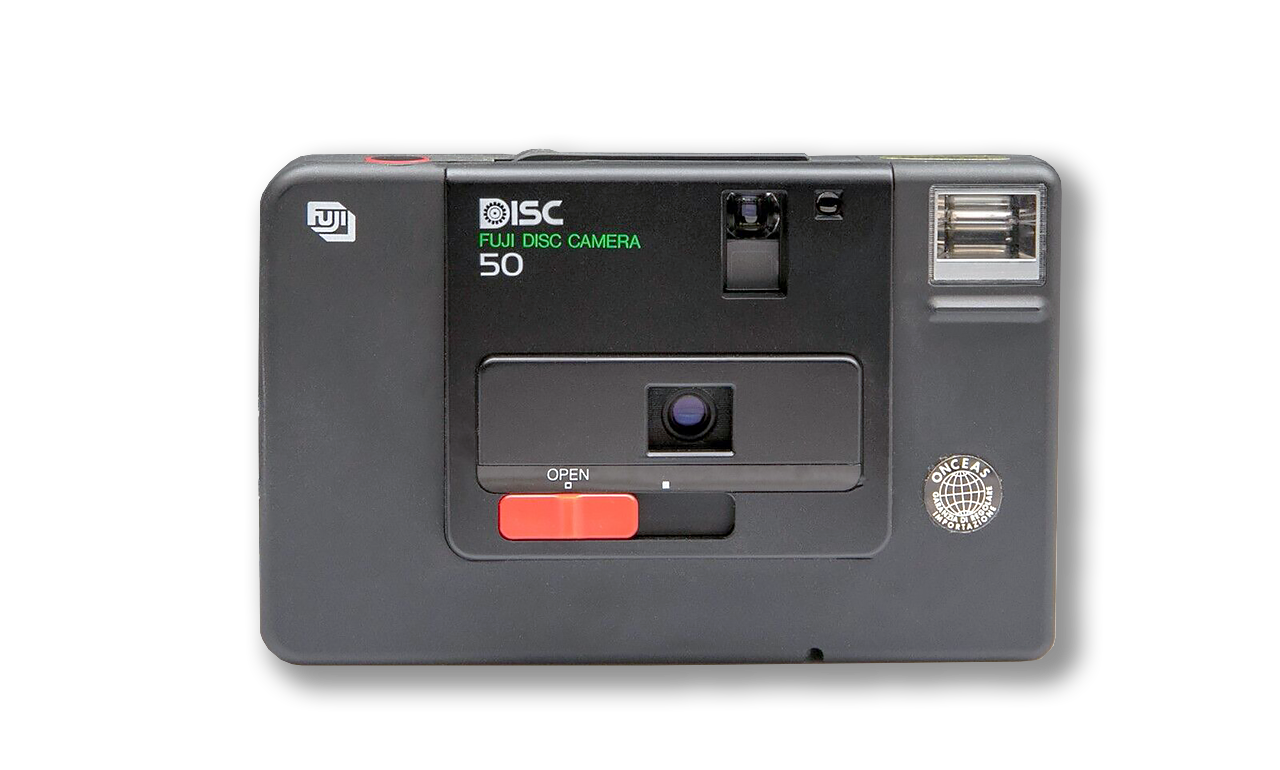
The Fuji Disc 50 Camera.
The Fujica 35-ML is a 35mm film camera from Fuji, advertised in the US beginning in 1958.It is a minor update to the previous Fujica 35-M released months earlier. It features a coupled parallax corrected rangefinder. Unusual features are a baseplate winding lever, thumbwheel focus on the rear of the body, and a rewind crank turned 90° sideways.
The Fujica Drive is a 35mm film half-frame viewfinder camera made by Fuji and introduced in 1964. The camera could be used in fully automatic or manual exposure with the Selenium cell meter. The camera has a spring-motor. One complete winding for 18 consecutive pictures by a large knob on the bottom of the camera.
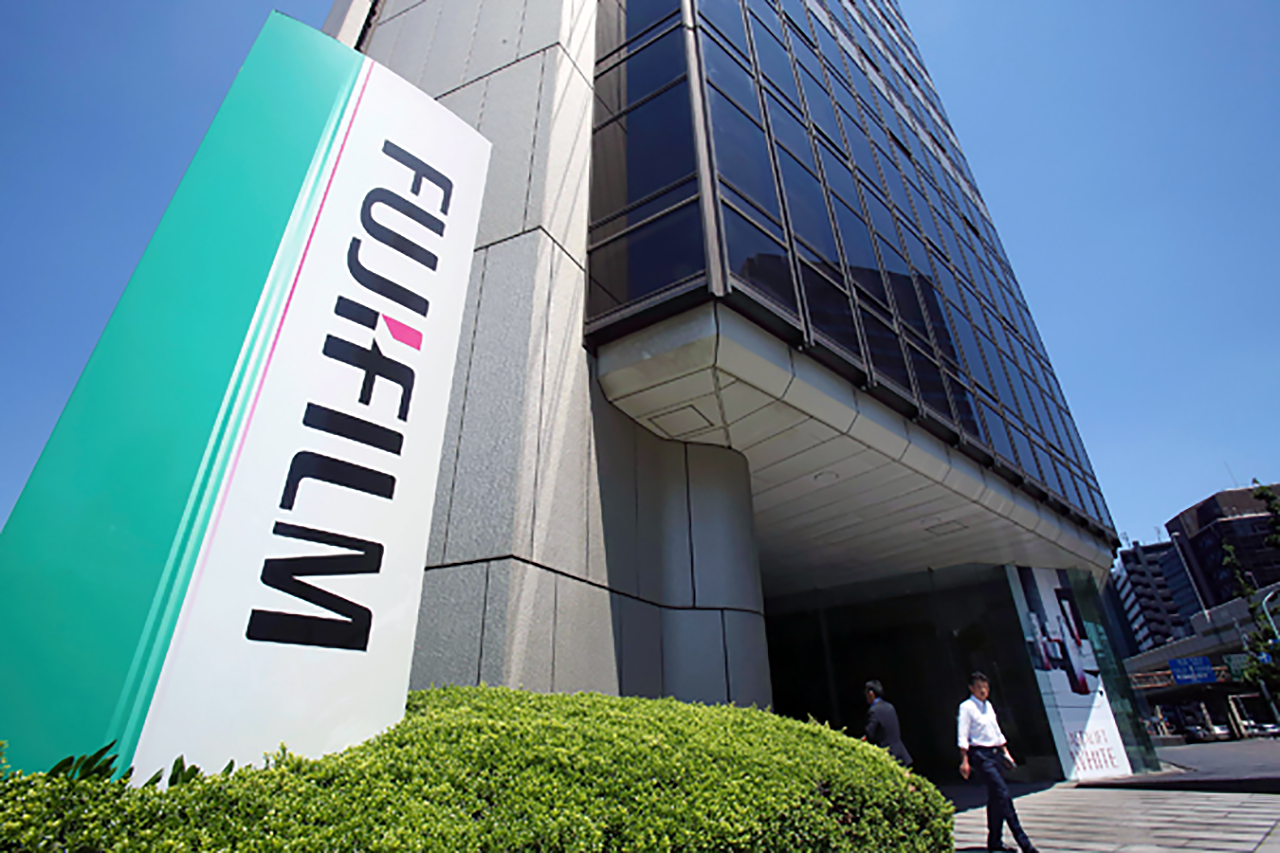
Skyline of Minamiashigara City, a city in the prefecture of Kanagawa, at the foot of Mount Hakone
Colour
Fujichrome
Astia
Fortia SP50
Provia
Sensia
RTP T64 Tungsten (135, 120, 4×5, 8×10)
RTPII T64 Tungsten (135)
Velvia
Fujicolor
Fujicolor Pro
Fujicolor consumer
C
ProPlus II
Reala
Superia
Press
Z
Black & white
Fujifilm Neopan
Fujifilm Acros (ISO 100)
Fujifilm Presto (ISO 400)
instant film
Instax series films ISO 800.
Instax Wide (99x62mm)
Instax Wide Monochrome (99x62mm)
Instax Mini (46x62mm)
Instax Mini Monochrome (46x62mm) (10.2016)
Instax SQUARE (62x62mm) (Spring 2017)
Instax SQUARE Monochrome (62x62mm) (11.2020)
Instax Digital Pivi (46x61mm)
Instant packfilm
3¼ × 4¼” (85 × 108mm)
FP-100C, ISO 100, color glossy finish
FP-100C Silk, ISO 100, color
FP-100B, ISO 100, black and white
FP-400B, ISO 400, black and white
FP-3000B, ISO 3000, black and white
Instant packfilm
4×5″ (102 × 131mm)(Discontinued)
For use in the Fujifilm PA-45 or Polaroid Type 550 series film holders
FP-100C45, ISO 100, color glossy finish
FP-100B45 Super, ISO 100, black and white
FP-500B45 Super, ISO 500, black and white
FP-3000B45 Super, ISO 3000, black and white
APS film
Nexia

FOUNDING DATE: 1934
FOUNDER: Asano Shūichi (1rst CEO)
History
Fuji Photo Film Co., Ltd. was established in 1934 as a subsidiary of Daicel with the aim of producing photographic films. Over the following 10 years, the company produced photographic films, motion-picture films and X-ray films. In the 1940s, Fuji Photo entered the optical glasses, lenses and equipment markets. After the Second World War, Fuji Photo diversified, penetrating the medical (X-ray diagnosis), printing, electronic imaging and magnetic materials fields. In 1962, Fuji Photo and UK-based Rank Xerox Limited (now Xerox Limited) launched Fuji Xerox Co., Ltd. through a joint venture.
From the mid-1950s, Fuji Photo accelerated the establishment of overseas sales bases. In the 1980s, Fuji Photo expanded its production and other bases overseas, stepping up the pace of its business globalization. Meanwhile, Fuji Photo developed digital technologies for its photo-related, medical and printing businesses. As a result, it invented computed radiography (CR), which solved a number of issues of traditional radiography, resulting a decrease of radiation exposure to both technician and patient. Fujifilm’s systems were marketed and sold under the FCR brand.
Sponsor of the 1984 Los Angeles Olympics instead of Kodak
Like its rival Eastman Kodak which dominated in the US, Fuji Photo enjoyed a longtime near-monopoly on camera film in Japan. By becoming one of the title sponsors of the 1984 Los Angeles Olympics (an opportunity that Kodak passed on), offering cheaper camera film, and establishing a film factory in the US, Fuji gained considerable market share there, while Kodak had little success in penetrating Japan.
In 1994 the vice president Juntarō Suzuki announced that the company would halt paying Sōkaiya, a type of protection racket bribe, to Yakuza. In retaliation of this he was murdered in front of his home by them.
In May 1995, Kodak filed a petition with the US Commerce Department under section 301 of the Commerce Act arguing that its poor performance in the Japanese market was a direct result of unfair practices adopted by Fuji. The complaint was lodged by the US with the World Trade Organization. On January 30, 1998, the WTO announced a “sweeping rejection of Kodak’s complaints” about the film market in Japan.
FOUNDER: Fritz Kuhnert
COMPANY NAMES:
1942: Optische Anstalt Fritz Kuhnert; 1951: Futura Kamerawerk AG Freiburg GmbH; 1956: closed down.
COMPANY ADDRESSES:
1942: Lehener Straße, Freiburg/Breisgau, Germany; 1947: Gundelfingen, Germany;
Considering the high standards set by other German camera makers like Leitz and Zeiss, the Futura was likely doomed to fail in the marketplace, and that’s exactly what happened. Today, Futura cameras enjoy a positive reputation from collectors who like interchangeable lens German rangefinders, but want something different than Leicas.
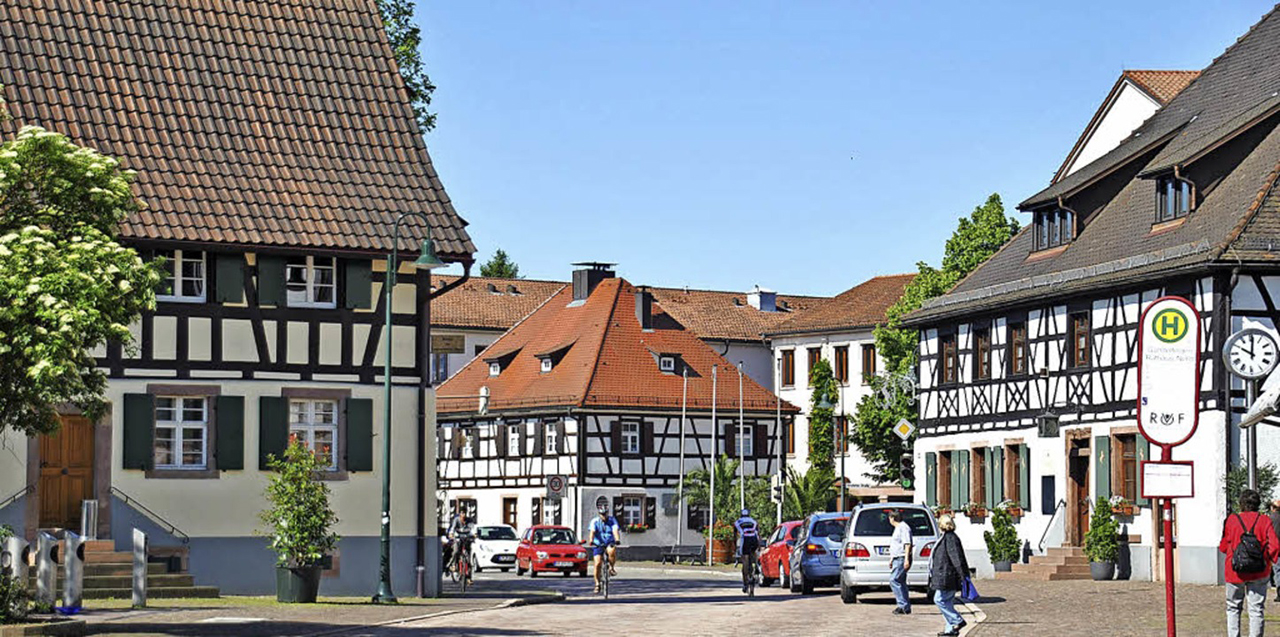
City center of Gundelfingen
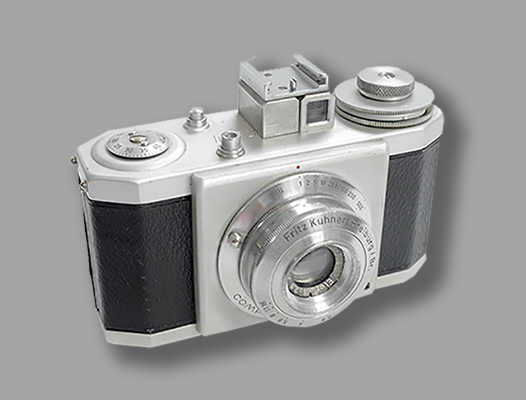
The Efka 24 camera from c1947. It takes 24×24 pictures on 35mm film; It has a retractable rapid-wind lever & Compur Rapid shutter + 4cm f2.8 Elor interchangeable screw mount lens. Has added top plate accessory shoe.
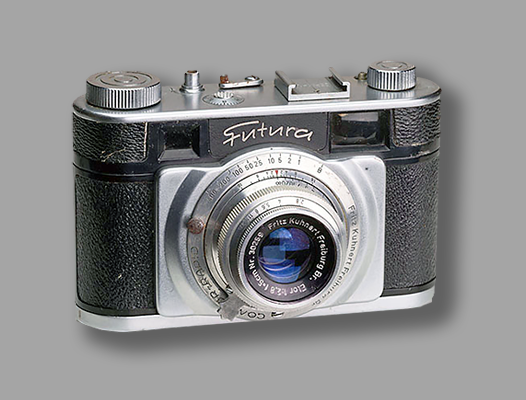
The first model, introduced in 1950, was what became known as the Futura Standard.
It had the Futura name written in script font between the rangefinder windows and was equipped with Futura’s own range of 50mm lenses, including an impressively fast (for the time) 50mm f/1.5 Frilon, designed by a former employee from Schneider.
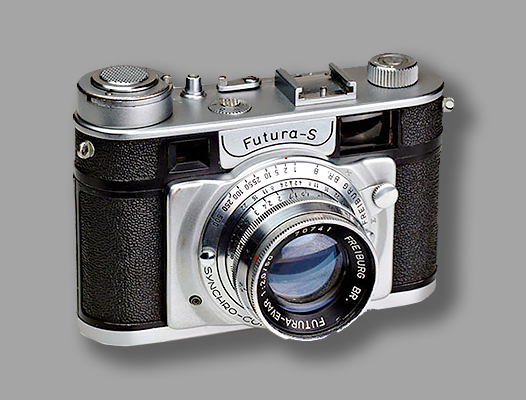
The last major upgrade was the Futura-S in 1953, which had a Synchro-Compur shutter and an updated lens mount which allowed full coupling of wide and telelenses to the rangefinder.
The front of the camera was modernised, with a metal nameplate and the name of the company moving to the shutter speed dial once again. The camera also finally got some strap lugs.
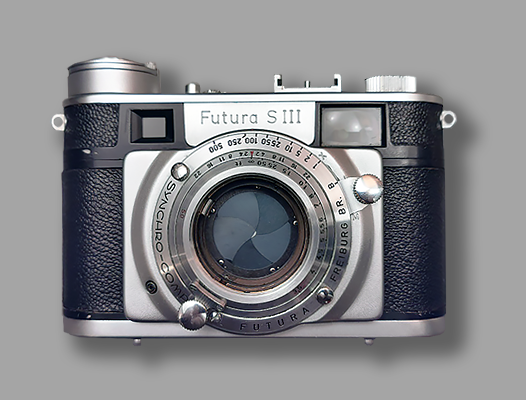
A special version was the SIII, introduced in 1956, which had a lever wind instead of a wind knob, although this was already available as an option on the Futura-S.
It appears that the SIII was an export version for the USA only. Perhaps it was simply introduced to raise new interest in the brand, as not much had happened since the introduction of the Futura-S three years earlier.
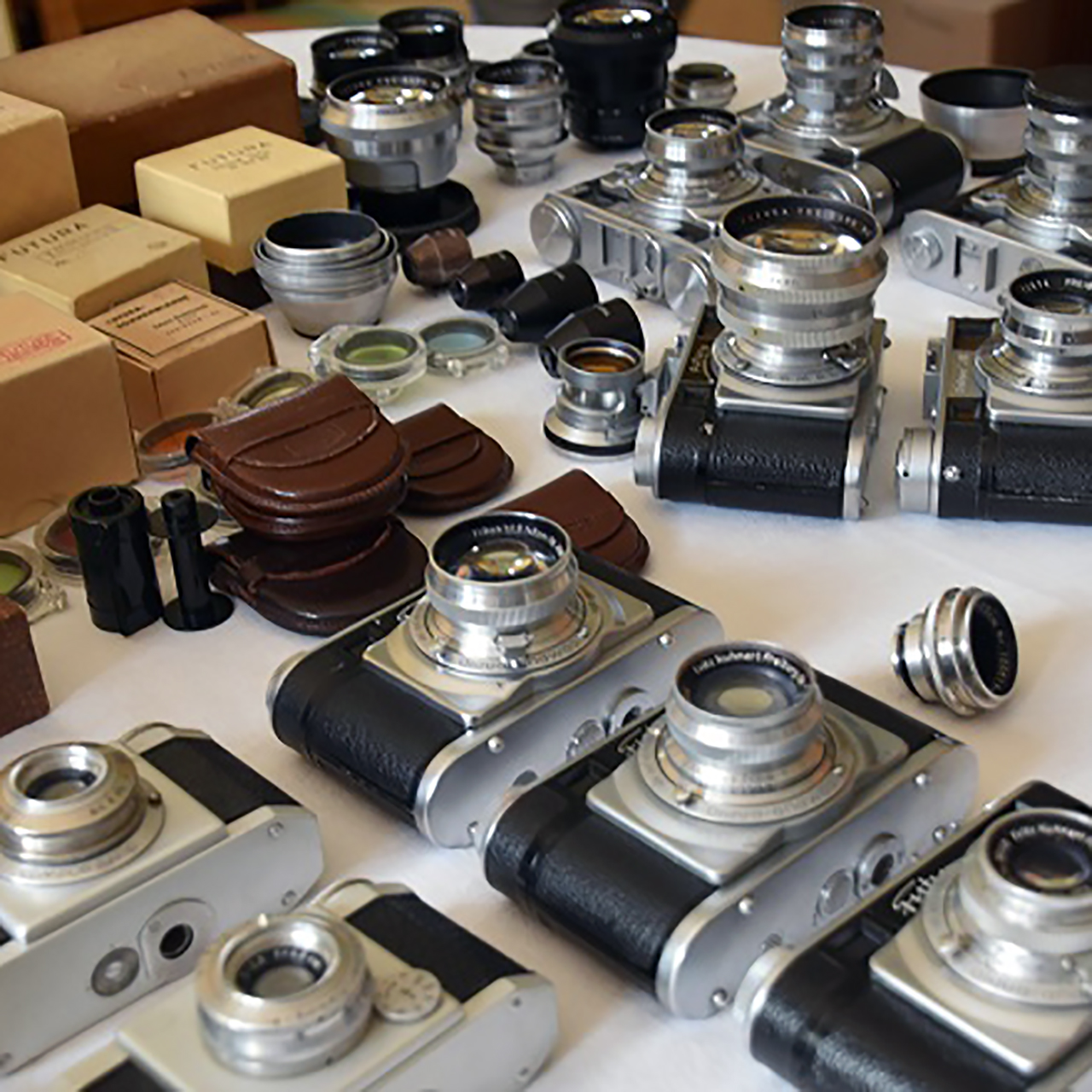
A collection of Futura cameras and accessories in a museum in Freiburg.
In the world of German cameras, there are many well established brands. Leica, Zeiss, Voigtländer, and Kodak all produced wonderful cameras over many decades that are still very sought after today. But behind the success stories are a large number of brands that for one reason or another fell by the wayside, Apparate & Kamerabau, Bilora, Ising, and Leidolf are some of the many companies that either merged with a larger company or just closed their doors never to be heard from again.
One company that falls into that second category too, is Futura. Originally formed in 1942 as an optics factory by the name, Fritz Kuhnert, Optische Anstalt, the company produced optical equipment for the German war effort in the Lehener Straße of Freiburg/Breisgau, and had been destroyed during World War II. Not much else is known about the company or it’s founder, Fritz Kuhnert.
a new factory in Gundelfingen
After the war its founder Fritz Kuhnert built a new factory nearby in Gundelfingen and started manufacturing cameras in 1946. Fritz Kuhnert’s initials F.K. should be the name of his first system camera: the Efka 24. All parts, including those for the later “Futura” model, were manufactured in the Freiburg factory.
Kuhnert named the lenses after his wife Eleonore, his daughter Eva and his son Peter. The lenses from Freiburg became famous worldwide under the names “Elor”, “Evar” and “Petar” – also because of their very high light intensity for the time.
In 1947 he introduced the Efka 24, a viewfinder camera for 24x24mm frame format. It is also remarkable how many accessories there were: universal viewfinders, lens hoods, repro stands, close-up extension rings. Until 1951 inscription on lenses and shutter face is “Fritz Kuhnert”, from 1951 on “Futura”.
Next, The Futura rangefinder camera became his flagship product, introduced at the first Photokina in 1950. The Futura was a cleanly designed 35mm rangefinder camera that shot normal 24mm x 36mm images. It had a combined coincident image rangefinder and a proprietary interchangeable screw lens mount.
The Futura S of 1952 was made for Futura’s interchangeable lenses. The “S” stood for Synchro-Compur. It’s a very nicely made 35mm rangefinder. About 9,000 were made before production ended in 1957.
After a few years, in 1951, the company ran out of money – it was sold to two brothers named Ernst and Eduard Komorowski of a Hamburg shipping company who renamed the company Futura Kamerawerk GmbH and continued producing the Futura lineup of cameras.
In an ad from September 1952, the Futura sold for between $127.95 to $197.25 depending on which lens it came with. When adjusted for inflation, these prices compare to $1230 to $1900 today which for a German made rangefinder with interchangeable lenses was quite a bargain.
Unfortunately, around 1956/1957, there was no interest in further modernizing the company, which would have been necessary to keep up with technical progress and to compete with the rapidly growing Japanese photo industry.
It was soon recognized that scrap sold better than cameras, so the factory was liquidated – and the camera industry in Freiburg died out. Furthermore, a planned takeover by Nedinsco company failed.
- Efka 24 (1947)
All Futuras have coupled rangefinders and interchangeable lenses
- Futura (Standard) with Compur lock (1951)
Value today ± € 150,- - Futura P with Prontor SV bolt (1952, the cheapest of the whole series)
Value today ± € 150,- - Futura S with Synchro-Compur shutter (1955)
Value today ± € 180,- – € 250,- - Futura S III with film transport lever and the Futura Tower (1956)
Value today ± € 250,- – € 320,-
Lens calculations were done by lens maker Schneider’s optician Werner Giesbrecht for Futura. All lenses except Schneider’s original Xenar were of Futura’s own production. The lenses were named like Kuhnert’s family members: Elor like his wife Eleonore, Evar und Petar like his children Eva und Peter.
- Futura Ampligon 4.5/35
- Futura Futar 3.5/45
- Schneider Xenar 2.8/45
- Futura Frilon 1.5/50
- Futura Evar 2.0/50
- Futura Elor 2.8/50
- Futura Frilon 1.5/70
- Futura Tele Futar 3.8/75
- Futura Tele Elor 3.8/90
- Futura Tele-Elor 5.6/90 (needs Futura S/SIII)









